
unilm
Large-scale Self-supervised Pre-training Across Tasks, Languages, and Modalities
Stars: 19617
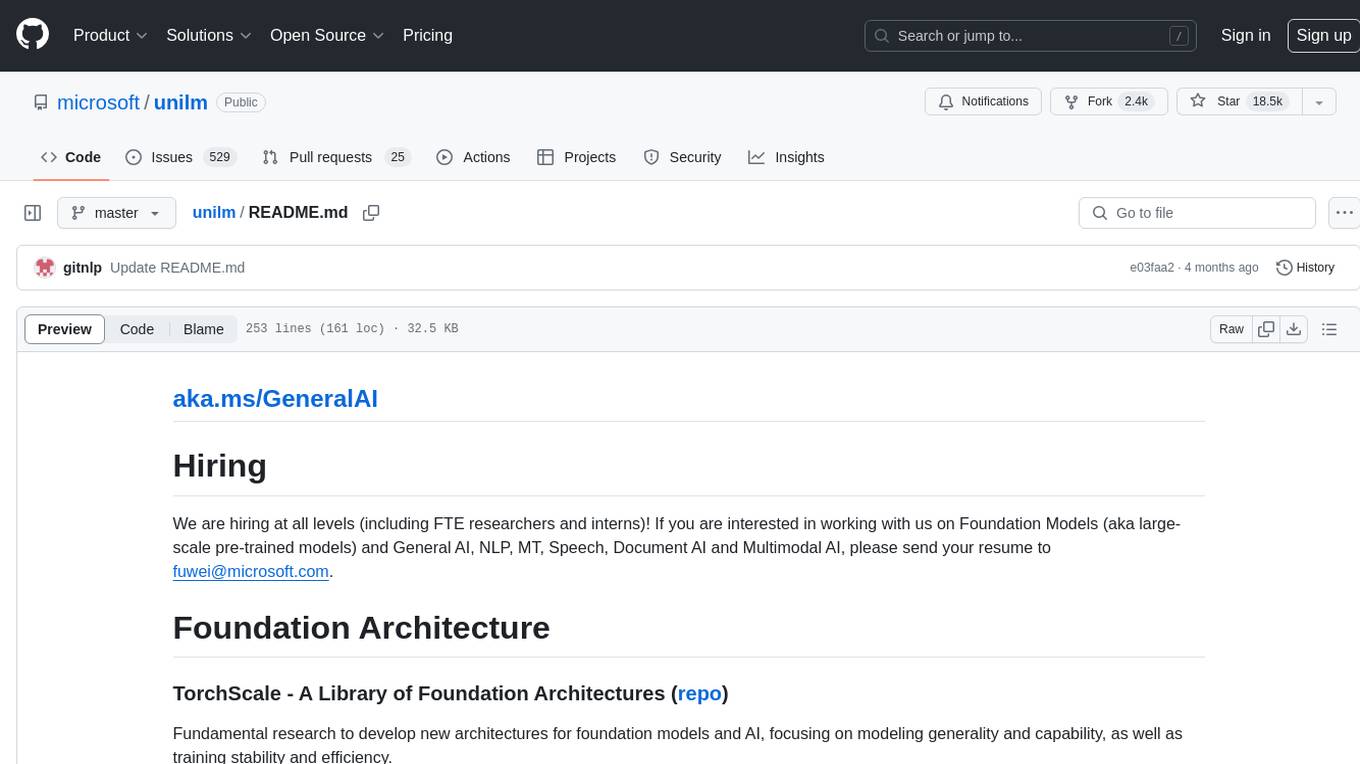
The 'unilm' repository is a collection of tools, models, and architectures for Foundation Models and General AI, focusing on tasks such as NLP, MT, Speech, Document AI, and Multimodal AI. It includes various pre-trained models, such as UniLM, InfoXLM, DeltaLM, MiniLM, AdaLM, BEiT, LayoutLM, WavLM, VALL-E, and more, designed for tasks like language understanding, generation, translation, vision, speech, and multimodal processing. The repository also features toolkits like s2s-ft for sequence-to-sequence fine-tuning and Aggressive Decoding for efficient sequence-to-sequence decoding. Additionally, it offers applications like TrOCR for OCR, LayoutReader for reading order detection, and XLM-T for multilingual NMT.
README:
We are hiring at all levels (including FTE researchers and interns)! If you are interested in working with us on Foundation Models (aka large-scale pre-trained models) and General AI, NLP, MT, Speech, Document AI and Multimodal AI, please send your resume to [email protected].
TorchScale - A Library of Foundation Architectures (repo)
Fundamental research to develop new architectures for foundation models and AI, focusing on modeling generality and capability, as well as training stability and efficiency.
Stability - DeepNet: scaling Transformers to 1,000 Layers and beyond
Generality - Foundation Transformers (Magneto): towards true general-purpose modeling across tasks and modalities (including language, vision, speech, and multimodal)
Capability - A Length-Extrapolatable Transformer
Efficiency & Transferability - X-MoE: scalable & finetunable sparse Mixture-of-Experts (MoE)
BitNet: 1-bit Transformers for Large Language Models
RetNet: Retentive Network: A Successor to Transformer for Large Language Models
LongNet: Scaling Transformers to 1,000,000,000 Tokens
Kosmos-2.5: A Multimodal Literate Model
Kosmos-2: Grounding Multimodal Large Language Models to the World
Kosmos-1: A Multimodal Large Language Model (MLLM)
MetaLM: Language Models are General-Purpose Interfaces
The Big Convergence - Large-scale self-supervised pre-training across tasks (predictive and generative), languages (100+ languages), and modalities (language, image, audio, layout/format + language, vision + language, audio + language, etc.)
UniLM: unified pre-training for language understanding and generation
InfoXLM/XLM-E: multilingual/cross-lingual pre-trained models for 100+ languages
DeltaLM/mT6: encoder-decoder pre-training for language generation and translation for 100+ languages
MiniLM: small and fast pre-trained models for language understanding and generation
AdaLM: domain, language, and task adaptation of pre-trained models
EdgeLM(
NEW): small pre-trained models on edge/client devices
SimLM (
NEW): large-scale pre-training for similarity matching
E5 (
NEW): text embeddings
MiniLLM (
NEW): Knowledge Distillation of Large Language Models
BEiT/BEiT-2: generative self-supervised pre-training for vision / BERT Pre-Training of Image Transformers
DiT: self-supervised pre-training for Document Image Transformers
TextDiffuser/TextDiffuser-2 (
NEW): Diffusion Models as Text Painters
WavLM: speech pre-training for full stack tasks
VALL-E: a neural codec language model for TTS
LayoutLM/LayoutLMv2/LayoutLMv3: multimodal (text + layout/format + image) Document Foundation Model for Document AI (e.g. scanned documents, PDF, etc.)
LayoutXLM: multimodal (text + layout/format + image) Document Foundation Model for multilingual Document AI
MarkupLM: markup language model pre-training for visually-rich document understanding
XDoc: unified pre-training for cross-format document understanding
UniSpeech: unified pre-training for self-supervised learning and supervised learning for ASR
UniSpeech-SAT: universal speech representation learning with speaker-aware pre-training
SpeechT5: encoder-decoder pre-training for spoken language processing
SpeechLM: Enhanced Speech Pre-Training with Unpaired Textual Data
VLMo: Unified vision-language pre-training
VL-BEiT (
NEW): Generative Vision-Language Pre-training - evolution of BEiT to multimodal
BEiT-3 (
NEW): a general-purpose multimodal foundation model, and a major milestone of The Big Convergence of Large-scale Pre-training Across Tasks, Languages, and Modalities.
s2s-ft: sequence-to-sequence fine-tuning toolkit
Aggressive Decoding (
NEW): lossless and efficient sequence-to-sequence decoding algorithm
TrOCR: transformer-based OCR w/ pre-trained models
LayoutReader: pre-training of text and layout for reading order detection
XLM-T: multilingual NMT w/ pretrained cross-lingual encoders
LLMOps (repo)
General technology for enabling AI capabilities w/ LLMs and MLLMs.
- December, 2023: LongNet and LongViT released
- [Model Release] Dec, 2023: TextDiffuser-2 models, code and demo.
- Sep, 2023: Kosmos-2.5 - a multimodal literate model for machine reading of text-intensive images.
- [Model Release] May, 2023: TextDiffuser models and code.
- [Model Release] March, 2023: BEiT-3 pretrained models and code.
- March, 2023: Kosmos-1 - a Multimodal Large Language Model (MLLM) that can perceive general modalities, learn in context (i.e., few-shot), and follow instructions (i.e., zero-shot).
- January, 2023: VALL-E a language modeling approach for text to speech synthesis (TTS), which achieves state-of-the-art zero-shot TTS performance. See https://aka.ms/valle for demos of our work.
- [Model Release] January, 2023: E5 - Text Embeddings by Weakly-Supervised Contrastive Pre-training.
- November, 2022: TorchScale 0.1.1 was released!
- November, 2022: TrOCR was accepted by AAAI 2023.
- [Model Release] November, 2022: XDoc BASE models for cross-format document understanding.
- [Model Release] September, 2022: TrOCR BASE and LARGE models for Scene Text Recognition (STR).
- [Model Release] September, 2022: BEiT v2 code and pretrained models.
- August, 2022: BEiT-3 - a general-purpose multimodal foundation model, which achieves state-of-the-art transfer performance on both vision and vision-language tasks
- July, 2022: SimLM - Large-scale self-supervised pre-training for similarity matching
- June, 2022: DiT and LayoutLMv3 were accepted by ACM Multimedia 2022.
- June, 2022: MetaLM - Language models are general-purpose interfaces to foundation models (language/multilingual, vision, speech, and multimodal)
- June, 2022: VL-BEiT - bidirectional multimodal Transformer learned from scratch with one unified pretraining task, one shared backbone, and one-stage training, supporting both vision and vision-language tasks.
- [Model Release] June, 2022: LayoutLMv3 Chinese - Chinese version of LayoutLMv3
- [Code Release] May, 2022: Aggressive Decoding - Lossless Speedup for Seq2seq Generation
- April, 2022: Transformers at Scale = DeepNet + X-MoE
- [Model Release] April, 2022: LayoutLMv3 - Pre-training for Document AI with Unified Text and Image Masking
- [Model Release] March, 2022: EdgeFormer - Parameter-efficient Transformer for On-device Seq2seq Generation
- [Model Release] March, 2022: DiT - Self-supervised Document Image Transformer. Demos: Document Layout Analysis, Document Image Classification
- January, 2022: BEiT was accepted by ICLR 2022 as Oral presentation (54 out of 3391).
- [Model Release] December 16th, 2021: TrOCR small models for handwritten and printed texts, with 3x inference speedup.
- November 24th, 2021: VLMo as the new SOTA on the VQA Challenge
- November, 2021: Multilingual translation at scale: 10000 language pairs and beyond
- [Model Release] November, 2021: MarkupLM - Pre-training for text and markup language (e.g. HTML/XML)
- [Model Release] November, 2021: VLMo - Unified vision-language pre-training w/ BEiT
- October, 2021: WavLM Large achieves state-of-the-art performance on the SUPERB benchmark
- [Model Release] October, 2021: WavLM - Large-scale self-supervised pre-trained models for speech.
- [Model Release] October 2021: TrOCR is on HuggingFace
- September 28th, 2021: T-ULRv5 (aka XLM-E/InfoXLM) as the SOTA on the XTREME leaderboard. // Blog
- [Model Release] September, 2021: LayoutLM-cased are on HuggingFace
- [Model Release] September, 2021: TrOCR - Transformer-based OCR w/ pre-trained BEiT and RoBERTa models.
- August 2021: LayoutLMv2 and LayoutXLM are on HuggingFace
- [Model Release] August, 2021: LayoutReader - Built with LayoutLM to improve general reading order detection.
- [Model Release] August, 2021: DeltaLM - Encoder-decoder pre-training for language generation and translation.
- August 2021: BEiT is on HuggingFace
- [Model Release] July, 2021: BEiT - Towards BERT moment for CV
- [Model Release] June, 2021: LayoutLMv2, LayoutXLM, MiniLMv2, and AdaLM.
- May, 2021: LayoutLMv2, InfoXLMv2, MiniLMv2, UniLMv3, and AdaLM were accepted by ACL 2021.
- April, 2021: LayoutXLM is coming by extending the LayoutLM into multilingual support! A multilingual form understanding benchmark XFUND is also introduced, which includes forms with human labeled key-value pairs in 7 languages (Chinese, Japanese, Spanish, French, Italian, German, Portuguese).
- March, 2021: InfoXLM was accepted by NAACL 2021.
- December 29th, 2020: LayoutLMv2 is coming with the new SOTA on a wide variety of document AI tasks, including DocVQA and SROIE leaderboard.
- October 8th, 2020: T-ULRv2 (aka InfoXLM) as the SOTA on the XTREME leaderboard. // Blog
- September, 2020: MiniLM was accepted by NeurIPS 2020.
- July 16, 2020: InfoXLM (Multilingual UniLM) arXiv
- June, 2020: UniLMv2 was accepted by ICML 2020; LayoutLM was accepted by KDD 2020.
- April 5, 2020: Multilingual MiniLM released!
- September, 2019: UniLMv1 was accepted by NeurIPS 2019.
This project is licensed under the license found in the LICENSE file in the root directory of this source tree. Portions of the source code are based on the transformers project.
Microsoft Open Source Code of Conduct
For help or issues using the pre-trained models, please submit a GitHub issue.
For other communications, please contact Furu Wei ([email protected]).
For Tasks:
Click tags to check more tools for each tasksFor Jobs:
Alternative AI tools for unilm
Similar Open Source Tools

unilm
The 'unilm' repository is a collection of tools, models, and architectures for Foundation Models and General AI, focusing on tasks such as NLP, MT, Speech, Document AI, and Multimodal AI. It includes various pre-trained models, such as UniLM, InfoXLM, DeltaLM, MiniLM, AdaLM, BEiT, LayoutLM, WavLM, VALL-E, and more, designed for tasks like language understanding, generation, translation, vision, speech, and multimodal processing. The repository also features toolkits like s2s-ft for sequence-to-sequence fine-tuning and Aggressive Decoding for efficient sequence-to-sequence decoding. Additionally, it offers applications like TrOCR for OCR, LayoutReader for reading order detection, and XLM-T for multilingual NMT.
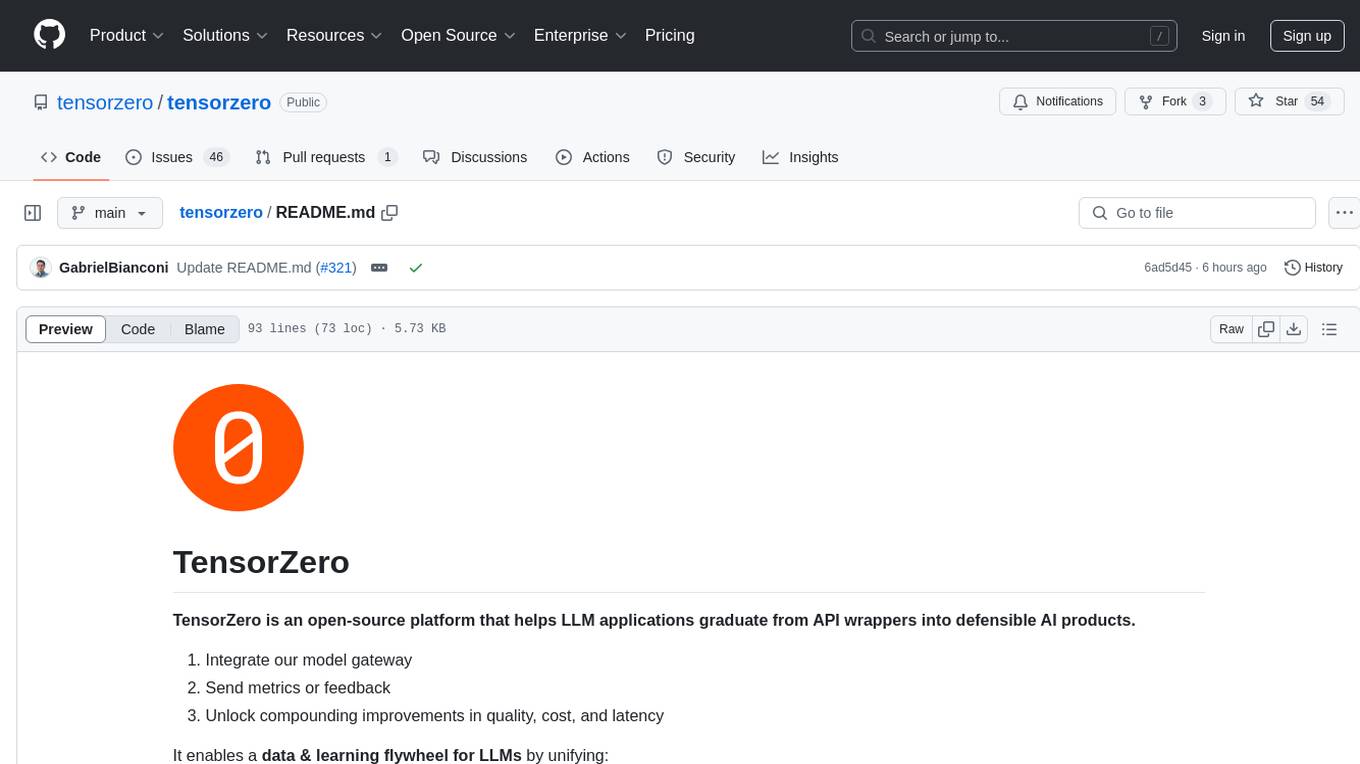
tensorzero
TensorZero is an open-source platform that helps LLM applications graduate from API wrappers into defensible AI products. It enables a data & learning flywheel for LLMs by unifying inference, observability, optimization, and experimentation. The platform includes a high-performance model gateway, structured schema-based inference, observability, experimentation, and data warehouse for analytics. TensorZero Recipes optimize prompts and models, and the platform supports experimentation features and GitOps orchestration for deployment.
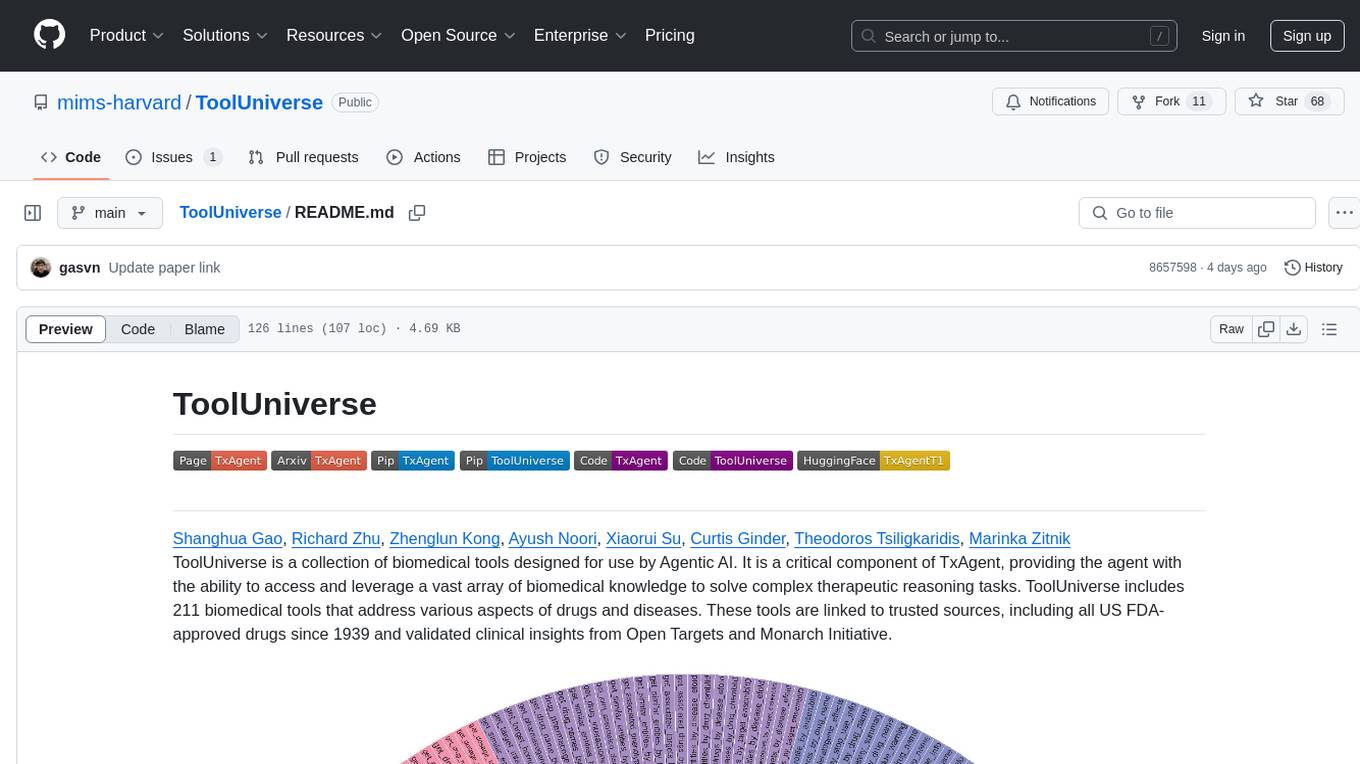
ToolUniverse
ToolUniverse is a collection of 211 biomedical tools designed for Agentic AI, providing access to biomedical knowledge for solving therapeutic reasoning tasks. The tools cover various aspects of drugs and diseases, linked to trusted sources like US FDA-approved drugs since 1939, Open Targets, and Monarch Initiative.
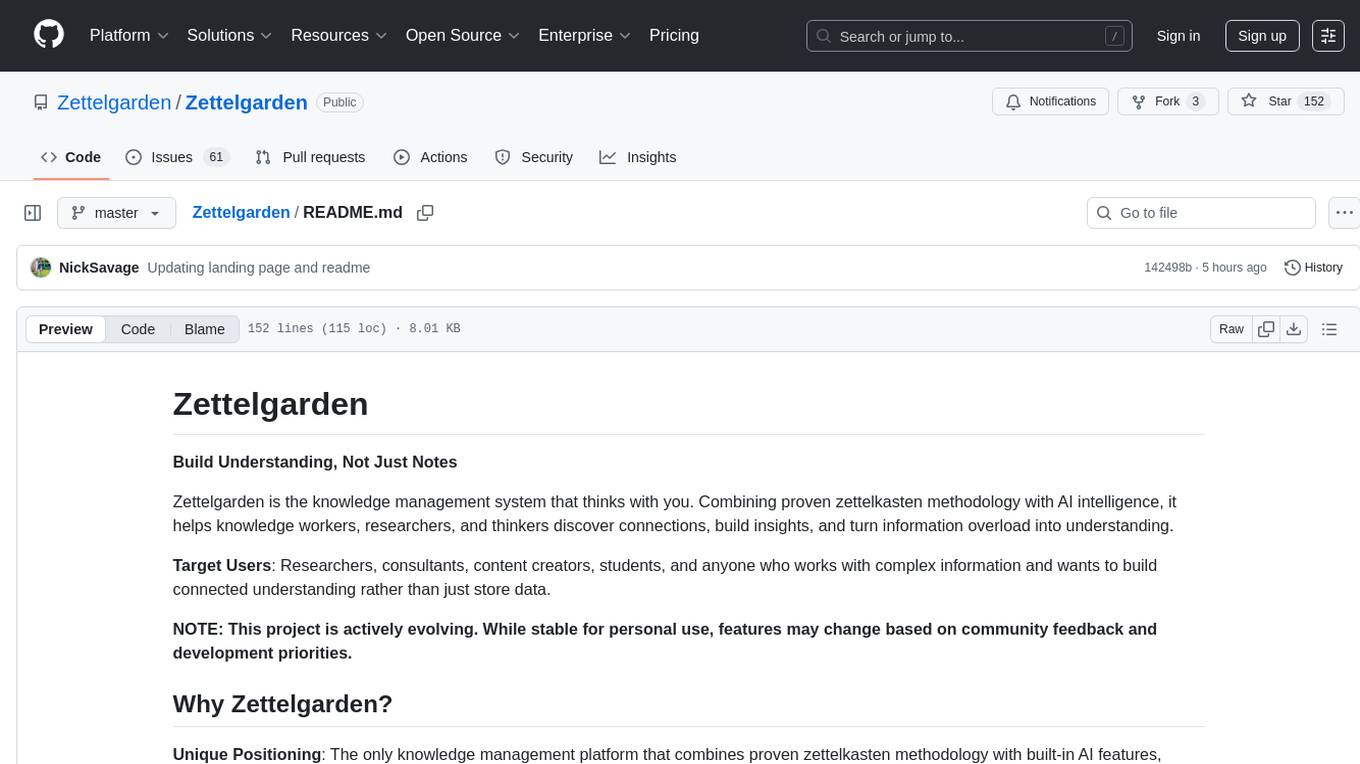
Zettelgarden
Zettelgarden is a human-centric, open-source personal knowledge management system that helps users develop and maintain their understanding of the world. It focuses on creating and connecting atomic notes, thoughtful AI integration, and scalability from personal notes to company knowledge bases. The project is actively evolving, with features subject to change based on community feedback and development priorities.
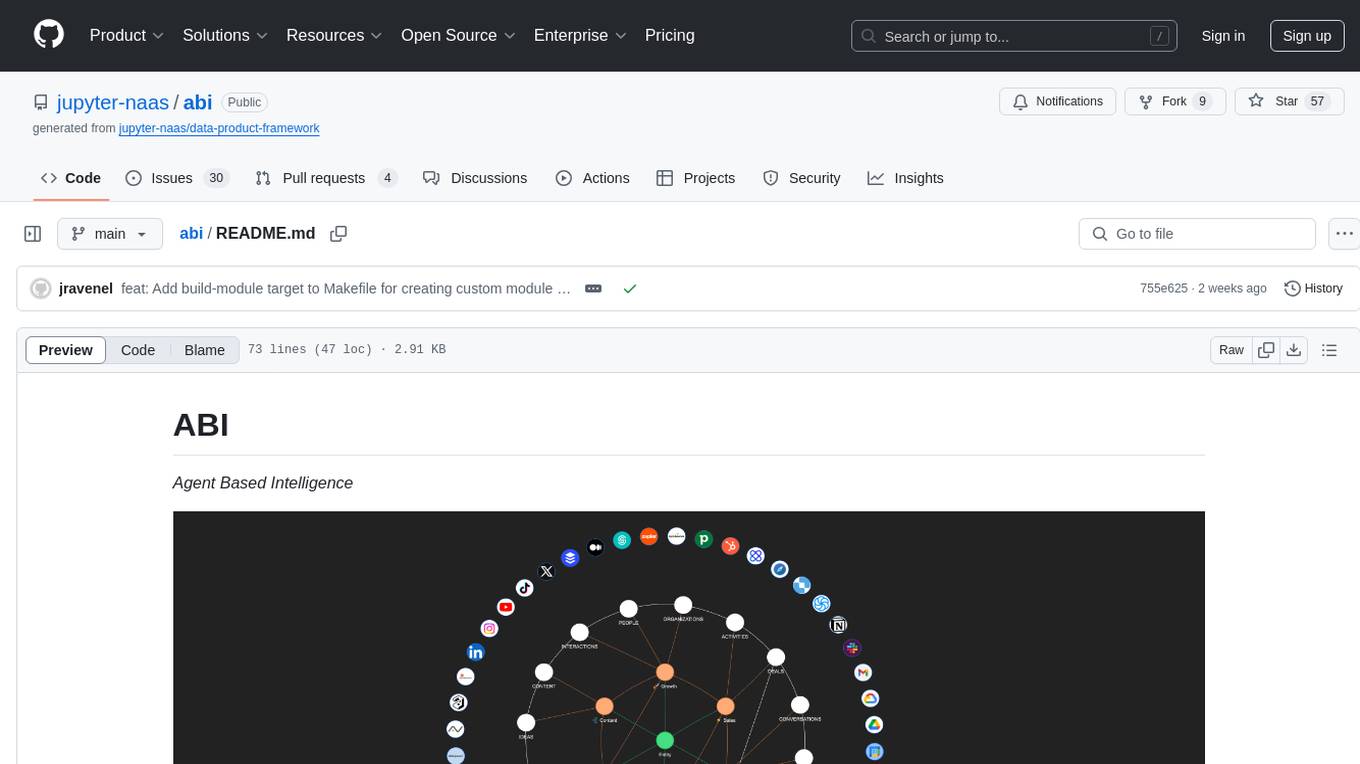
abi
ABI (Agentic Brain Infrastructure) is a Python-based AI Operating System designed to serve as the core infrastructure for building an Agentic AI Ontology Engine. It empowers organizations to integrate, manage, and scale AI-driven operations with multiple AI models, focusing on ontology, agent-driven workflows, and analytics. ABI emphasizes modularity and customization, providing a customizable framework aligned with international standards and regulatory frameworks. It offers features such as configurable AI agents, ontology management, integrations with external data sources, data processing pipelines, workflow automation, analytics, and data handling capabilities.
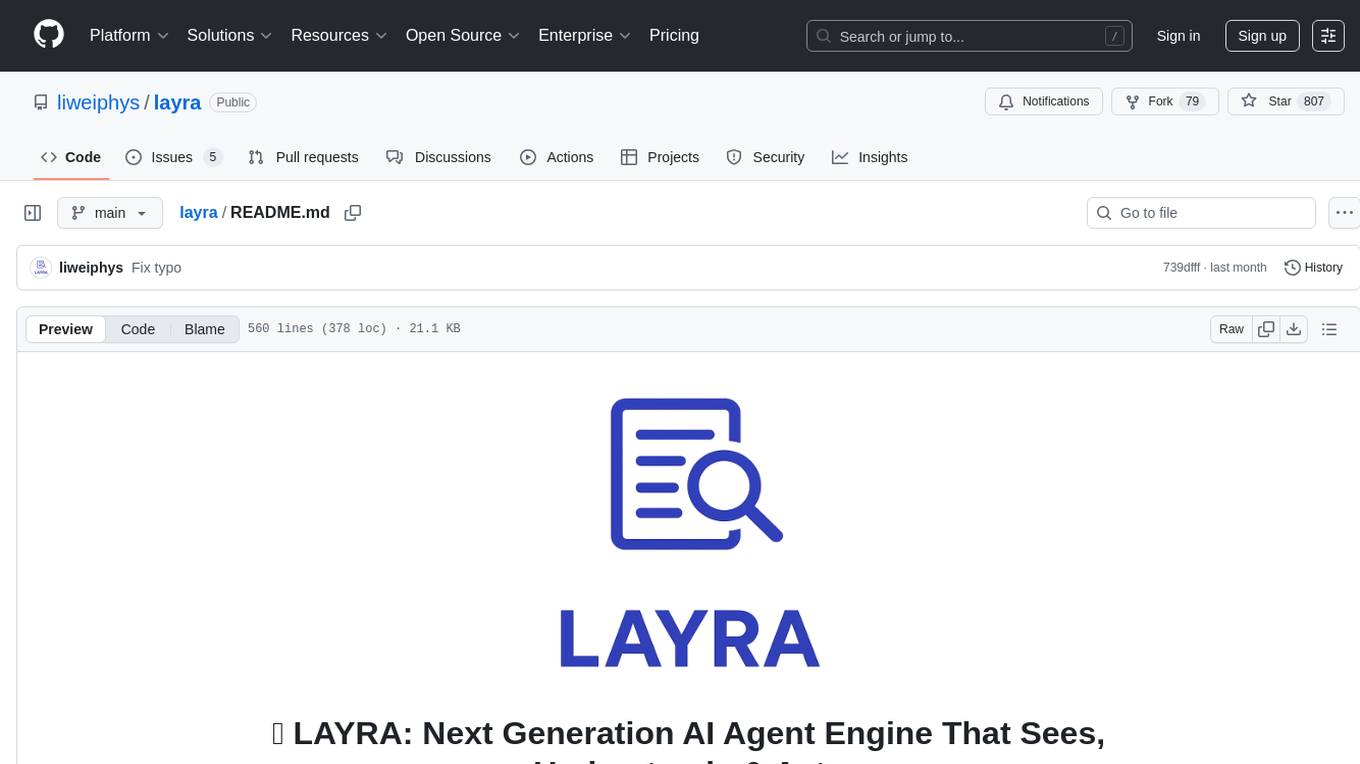
layra
LAYRA is the world's first visual-native AI automation engine that sees documents like a human, preserves layout and graphical elements, and executes arbitrarily complex workflows with full Python control. It empowers users to build next-generation intelligent systems with no limits or compromises. Built for Enterprise-Grade deployment, LAYRA features a modern frontend, high-performance backend, decoupled service architecture, visual-native multimodal document understanding, and a powerful workflow engine.
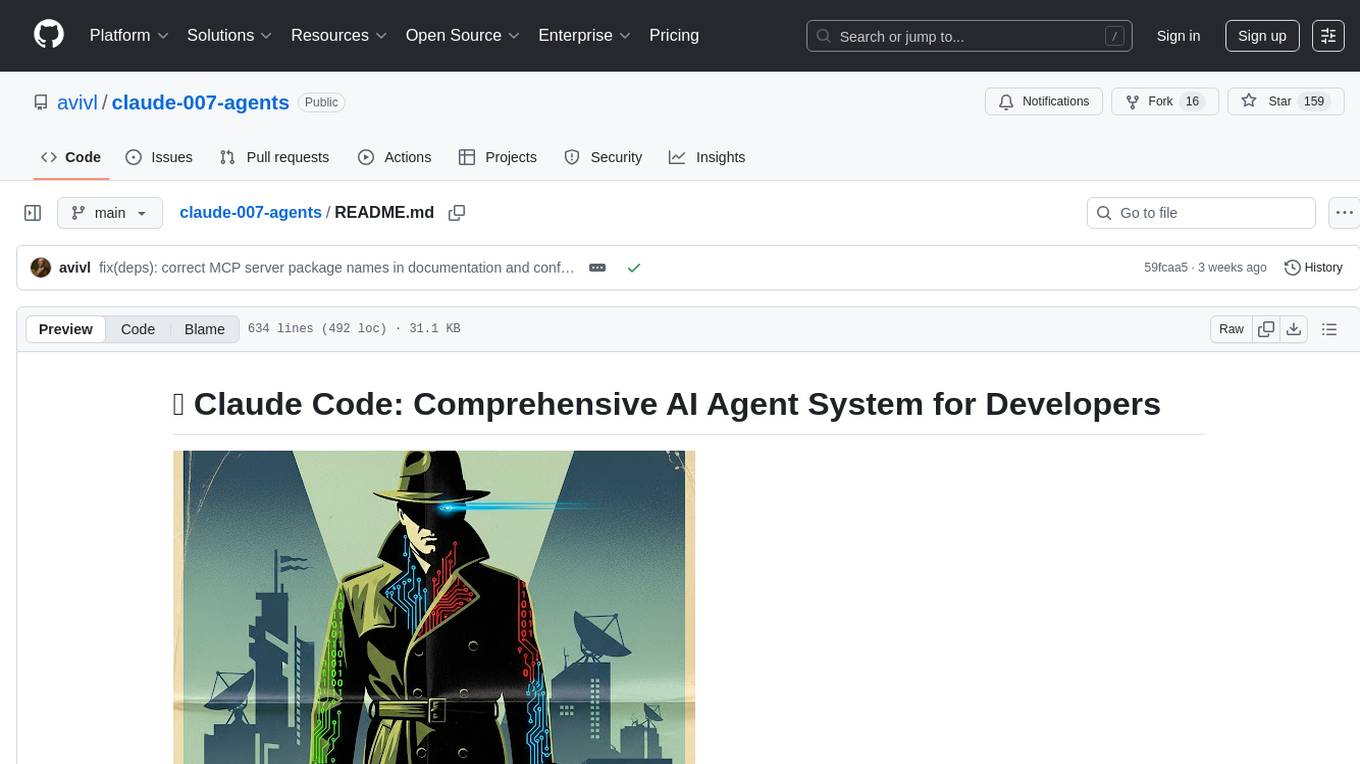
claude-007-agents
Claude Code Agents is an open-source AI agent system designed to enhance development workflows by providing specialized AI agents for orchestration, resilience engineering, and organizational memory. These agents offer specialized expertise across technologies, AI system with organizational memory, and an agent orchestration system. The system includes features such as engineering excellence by design, advanced orchestration system, Task Master integration, live MCP integrations, professional-grade workflows, and organizational intelligence. It is suitable for solo developers, small teams, enterprise teams, and open-source projects. The system requires a one-time bootstrap setup for each project to analyze the tech stack, select optimal agents, create configuration files, set up Task Master integration, and validate system readiness.
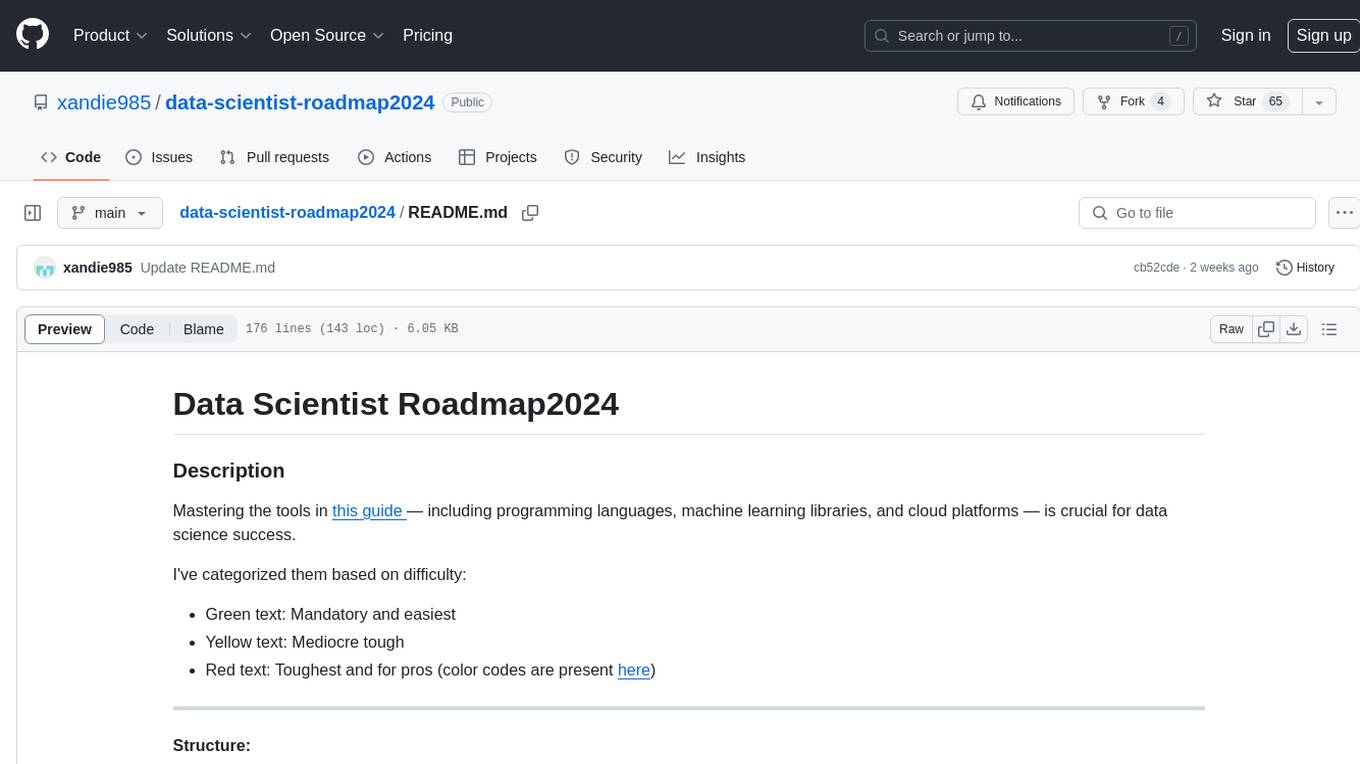
data-scientist-roadmap2024
The Data Scientist Roadmap2024 provides a comprehensive guide to mastering essential tools for data science success. It includes programming languages, machine learning libraries, cloud platforms, and concepts categorized by difficulty. The roadmap covers a wide range of topics from programming languages to machine learning techniques, data visualization tools, and DevOps/MLOps tools. It also includes web development frameworks and specific concepts like supervised and unsupervised learning, NLP, deep learning, reinforcement learning, and statistics. Additionally, it delves into DevOps tools like Airflow and MLFlow, data visualization tools like Tableau and Matplotlib, and other topics such as ETL processes, optimization algorithms, and financial modeling.
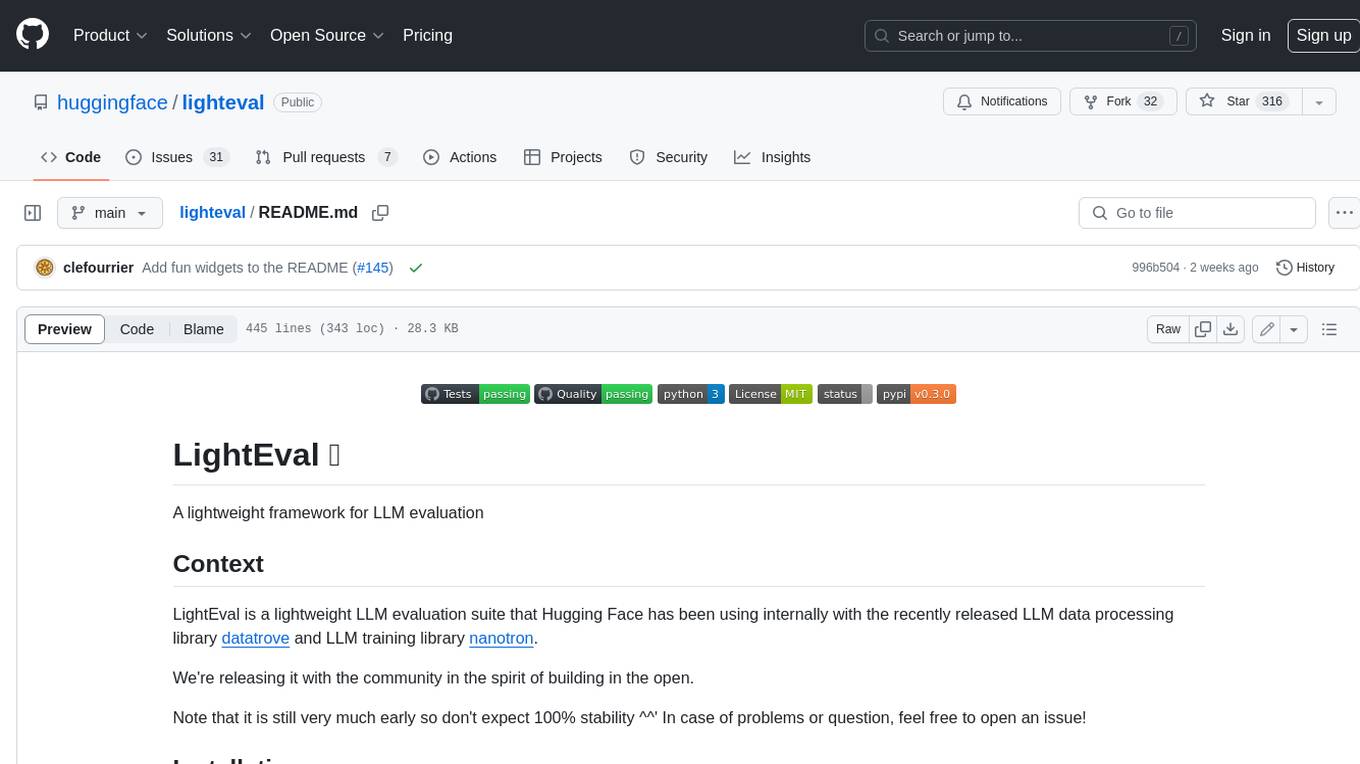
lighteval
LightEval is a lightweight LLM evaluation suite that Hugging Face has been using internally with the recently released LLM data processing library datatrove and LLM training library nanotron. We're releasing it with the community in the spirit of building in the open. Note that it is still very much early so don't expect 100% stability ^^' In case of problems or question, feel free to open an issue!
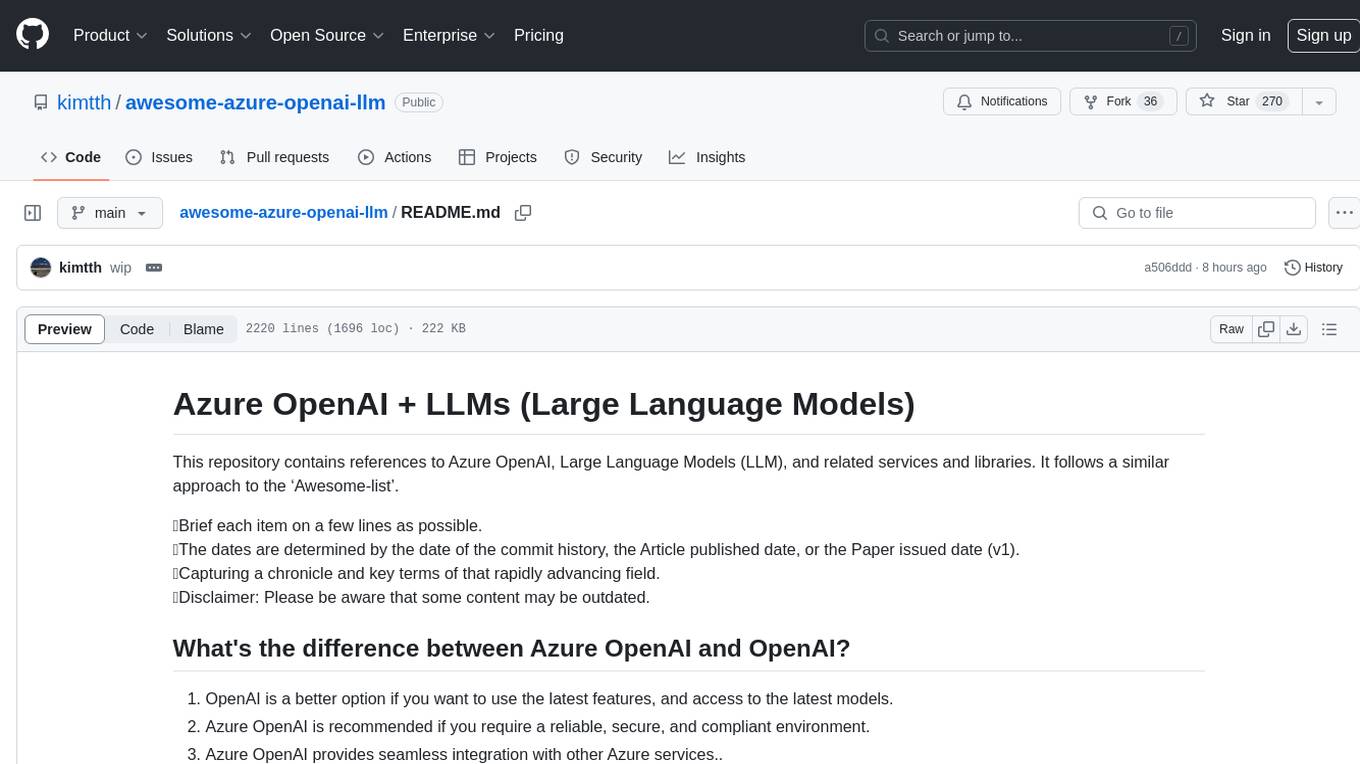
awesome-azure-openai-llm
This repository is a collection of references to Azure OpenAI, Large Language Models (LLM), and related services and libraries. It provides information on various topics such as RAG, Azure OpenAI, LLM applications, agent design patterns, semantic kernel, prompting, finetuning, challenges & abilities, LLM landscape, surveys & references, AI tools & extensions, datasets, and evaluations. The content covers a wide range of topics related to AI, machine learning, and natural language processing, offering insights into the latest advancements in the field.
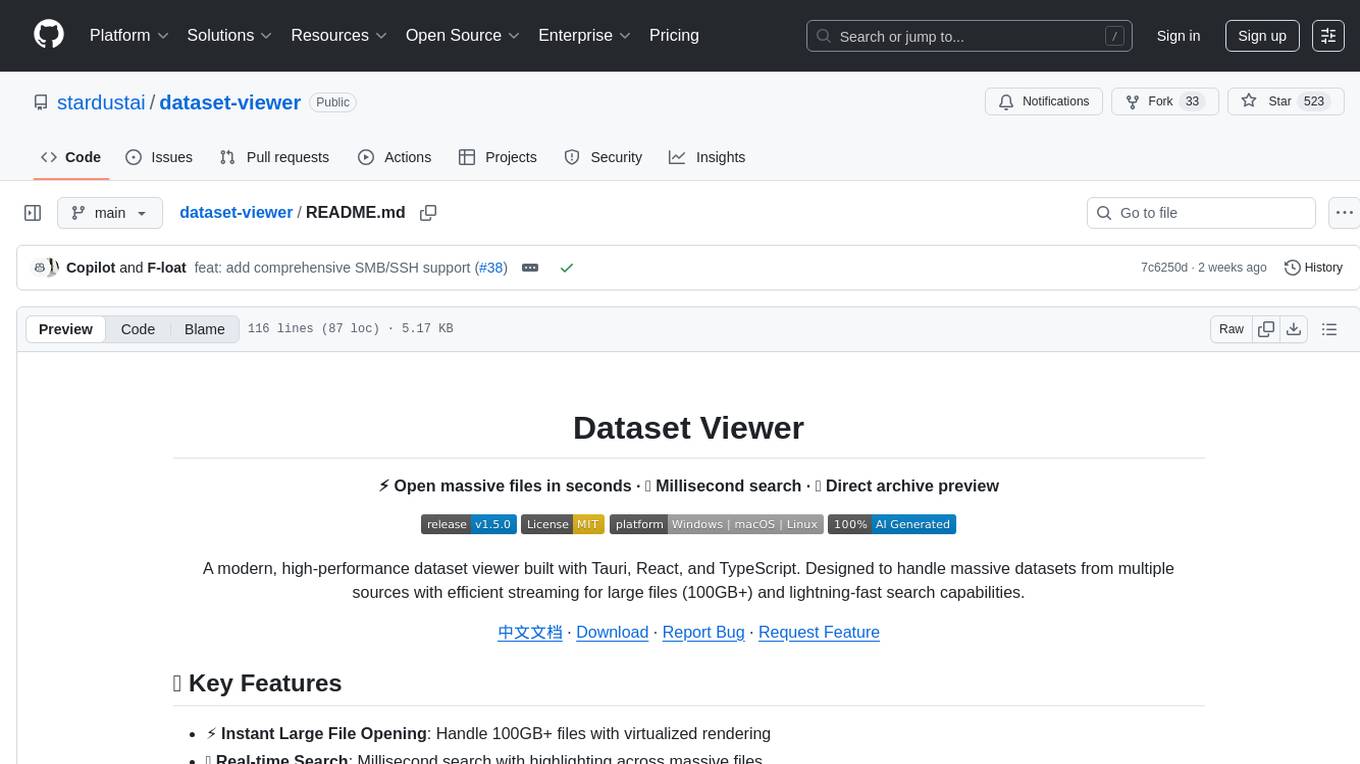
dataset-viewer
Dataset Viewer is a modern, high-performance tool built with Tauri, React, and TypeScript, designed to handle massive datasets from multiple sources with efficient streaming for large files (100GB+) and lightning-fast search capabilities. It supports instant large file opening, real-time search, direct archive preview, multi-protocol and multi-format support, and features a modern interface with dark/light themes and responsive design. The tool is perfect for data scientists, log analysis, archive management, remote access, and performance-critical tasks.
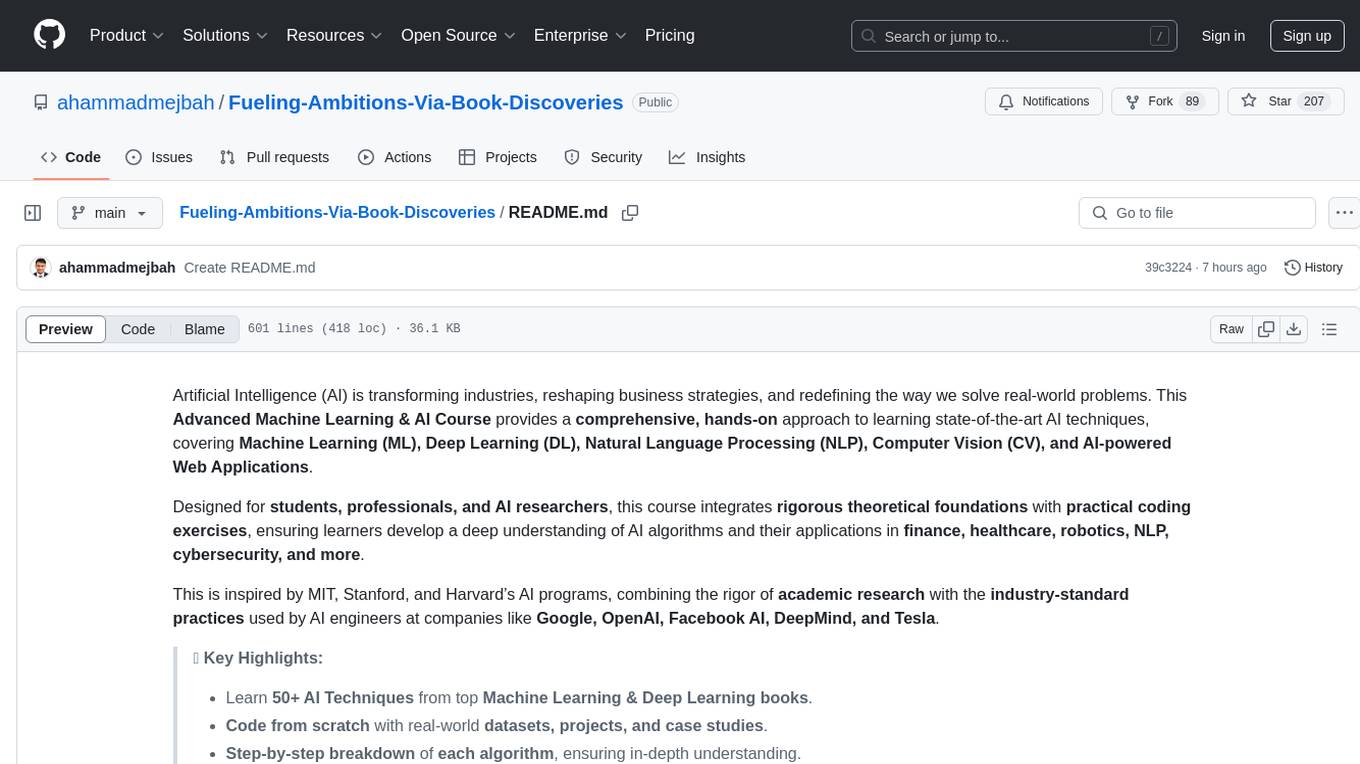
Fueling-Ambitions-Via-Book-Discoveries
Fueling-Ambitions-Via-Book-Discoveries is an Advanced Machine Learning & AI Course designed for students, professionals, and AI researchers. The course integrates rigorous theoretical foundations with practical coding exercises, ensuring learners develop a deep understanding of AI algorithms and their applications in finance, healthcare, robotics, NLP, cybersecurity, and more. Inspired by MIT, Stanford, and Harvard’s AI programs, it combines academic research rigor with industry-standard practices used by AI engineers at companies like Google, OpenAI, Facebook AI, DeepMind, and Tesla. Learners can learn 50+ AI techniques from top Machine Learning & Deep Learning books, code from scratch with real-world datasets, projects, and case studies, and focus on ML Engineering & AI Deployment using Django & Streamlit. The course also offers industry-relevant projects to build a strong AI portfolio.
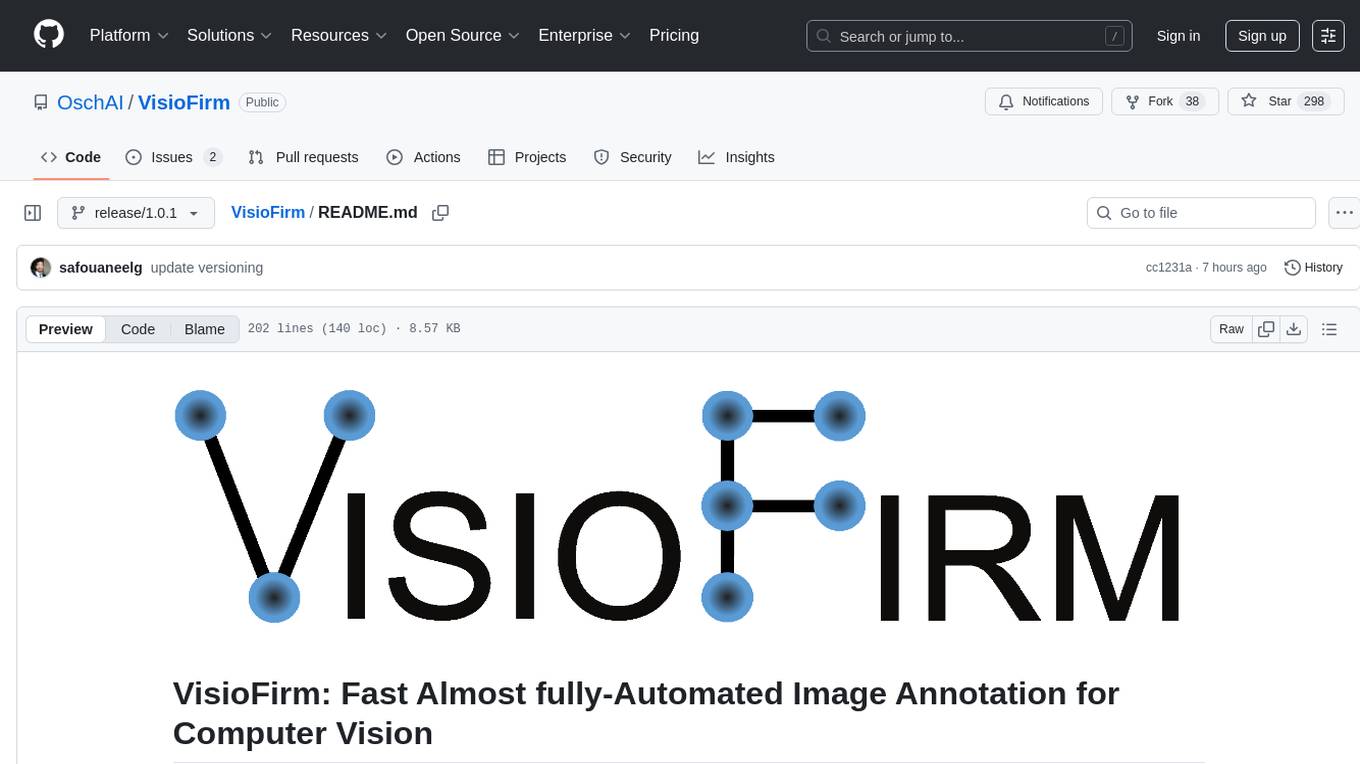
VisioFirm
VisioFirm is an open-source, AI-powered image annotation tool designed to accelerate labeling for computer vision tasks like classification, object detection, oriented bounding boxes (OBB), segmentation and video annotation. Built for speed and simplicity, it leverages state-of-the-art models for semi-automated pre-annotations, allowing you to focus on refining rather than starting from scratch. Whether you're preparing datasets for YOLO, SAM, or custom models, VisioFirm streamlines your workflow with an intuitive web interface and powerful backend. Perfect for researchers, data scientists, and ML engineers handling large image datasets—get high-quality annotations in minutes, not hours!
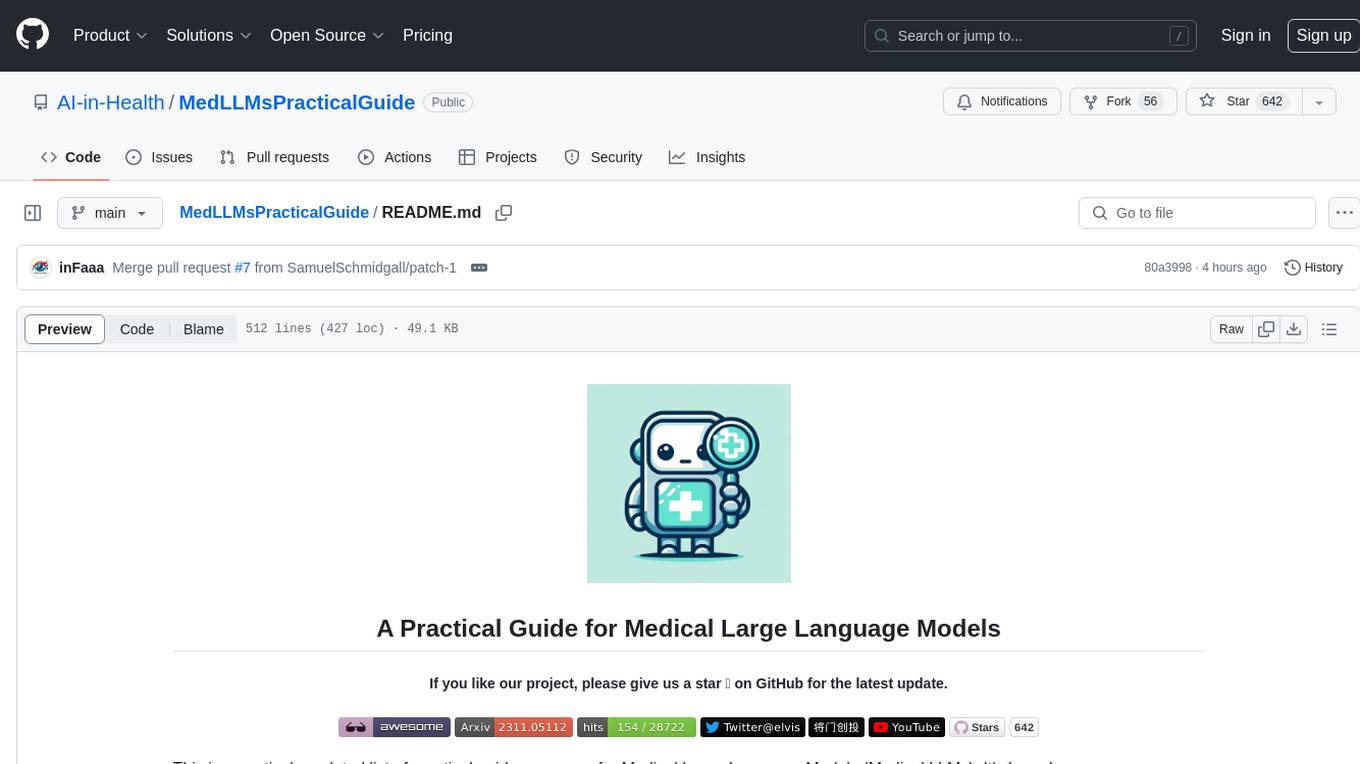
MedLLMsPracticalGuide
This repository serves as a practical guide for Medical Large Language Models (Medical LLMs) and provides resources, surveys, and tools for building, fine-tuning, and utilizing LLMs in the medical domain. It covers a wide range of topics including pre-training, fine-tuning, downstream biomedical tasks, clinical applications, challenges, future directions, and more. The repository aims to provide insights into the opportunities and challenges of LLMs in medicine and serve as a practical resource for constructing effective medical LLMs.
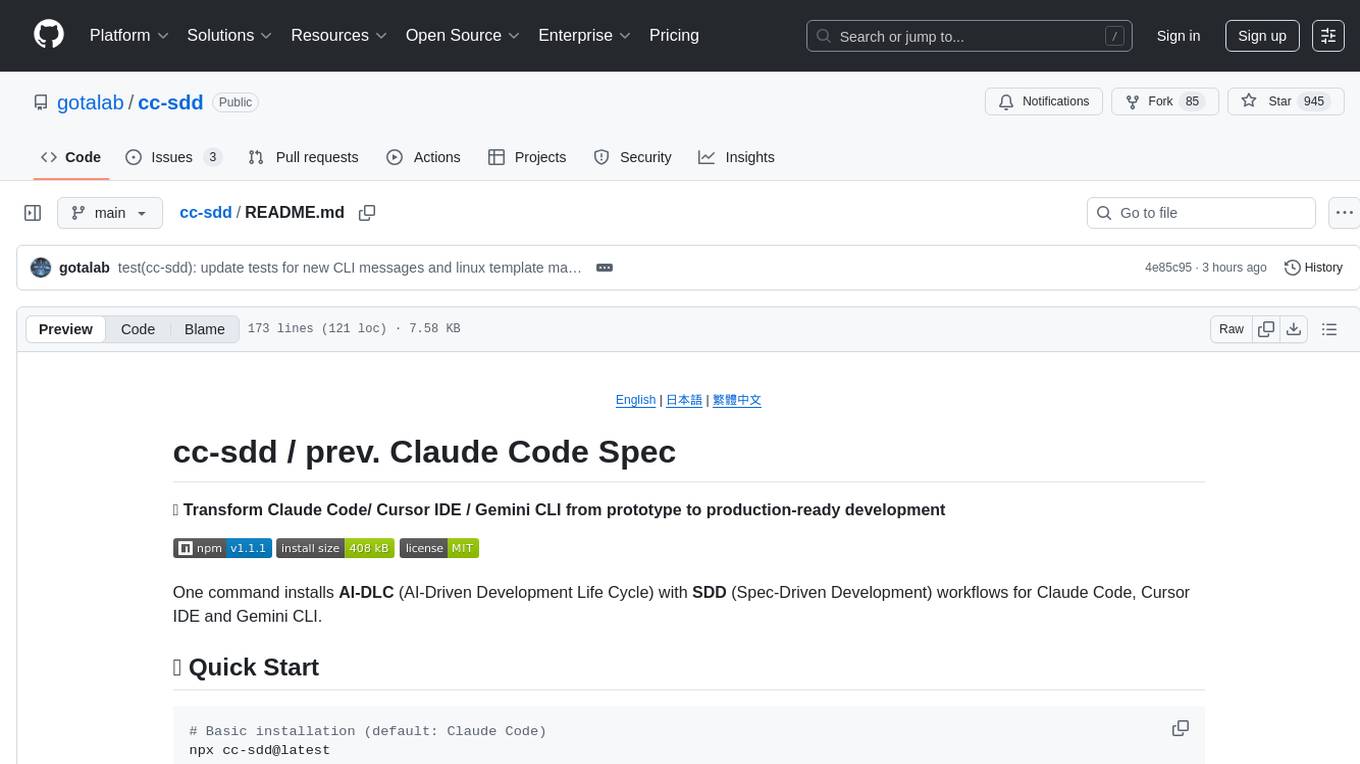
cc-sdd
The cc-sdd repository provides a tool for AI-Driven Development Life Cycle with Spec-Driven Development workflows for Claude Code and Gemini CLI. It includes powerful slash commands, Project Memory for AI learning, structured AI-DLC workflow, Spec-Driven Development methodology, and Kiro IDE compatibility. Ideal for feature development, code reviews, technical planning, and maintaining development standards. The tool supports multiple coding agents, offers an AI-DLC workflow with quality gates, and allows for advanced options like language and OS selection, preview changes, safe updates, and custom specs directory. It integrates AI-Driven Development Life Cycle, Project Memory, Spec-Driven Development, supports cross-platform usage, multi-language support, and safe updates with backup options.
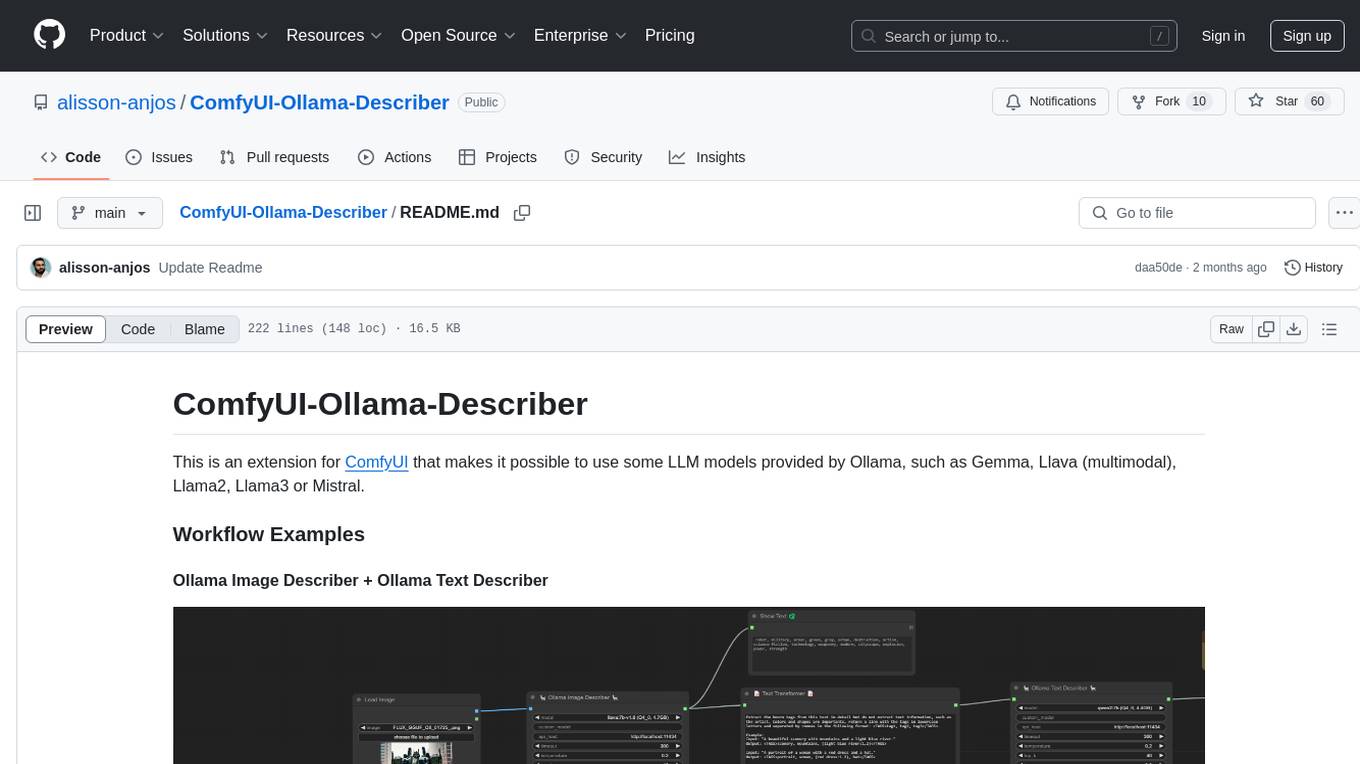
ComfyUI-Ollama-Describer
ComfyUI-Ollama-Describer is an extension for ComfyUI that enables the use of LLM models provided by Ollama, such as Gemma, Llava (multimodal), Llama2, Llama3, or Mistral. It requires the Ollama library for interacting with large-scale language models, supporting GPUs using CUDA and AMD GPUs on Windows, Linux, and Mac. The extension allows users to run Ollama through Docker and utilize NVIDIA GPUs for faster processing. It provides nodes for image description, text description, image captioning, and text transformation, with various customizable parameters for model selection, API communication, response generation, and model memory management.
For similar tasks
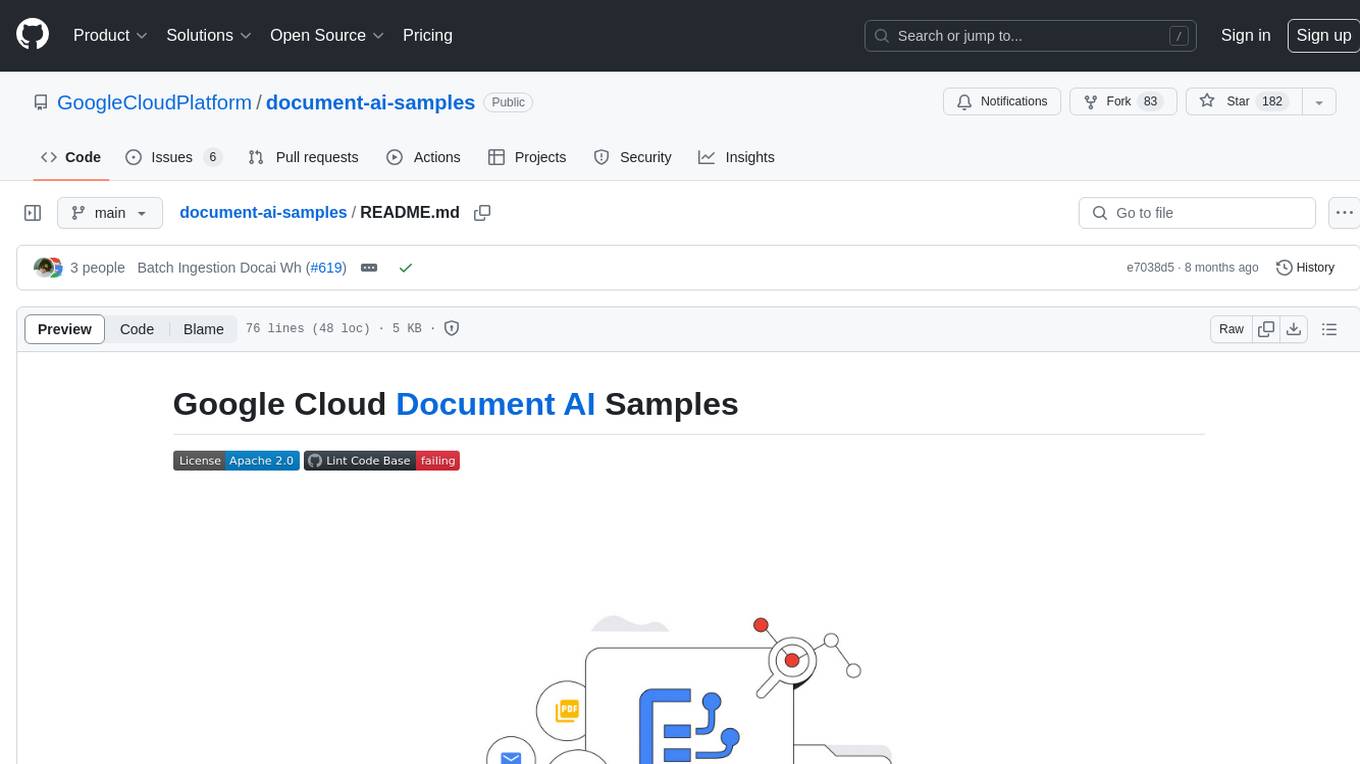
document-ai-samples
The Google Cloud Document AI Samples repository contains code samples and Community Samples demonstrating how to analyze, classify, and search documents using Google Cloud Document AI. It includes various projects showcasing different functionalities such as integrating with Google Drive, processing documents using Python, content moderation with Dialogflow CX, fraud detection, language extraction, paper summarization, tax processing pipeline, and more. The repository also provides access to test document files stored in a publicly-accessible Google Cloud Storage Bucket. Additionally, there are codelabs available for optical character recognition (OCR), form parsing, specialized processors, and managing Document AI processors. Community samples, like the PDF Annotator Sample, are also included. Contributions are welcome, and users can seek help or report issues through the repository's issues page. Please note that this repository is not an officially supported Google product and is intended for demonstrative purposes only.
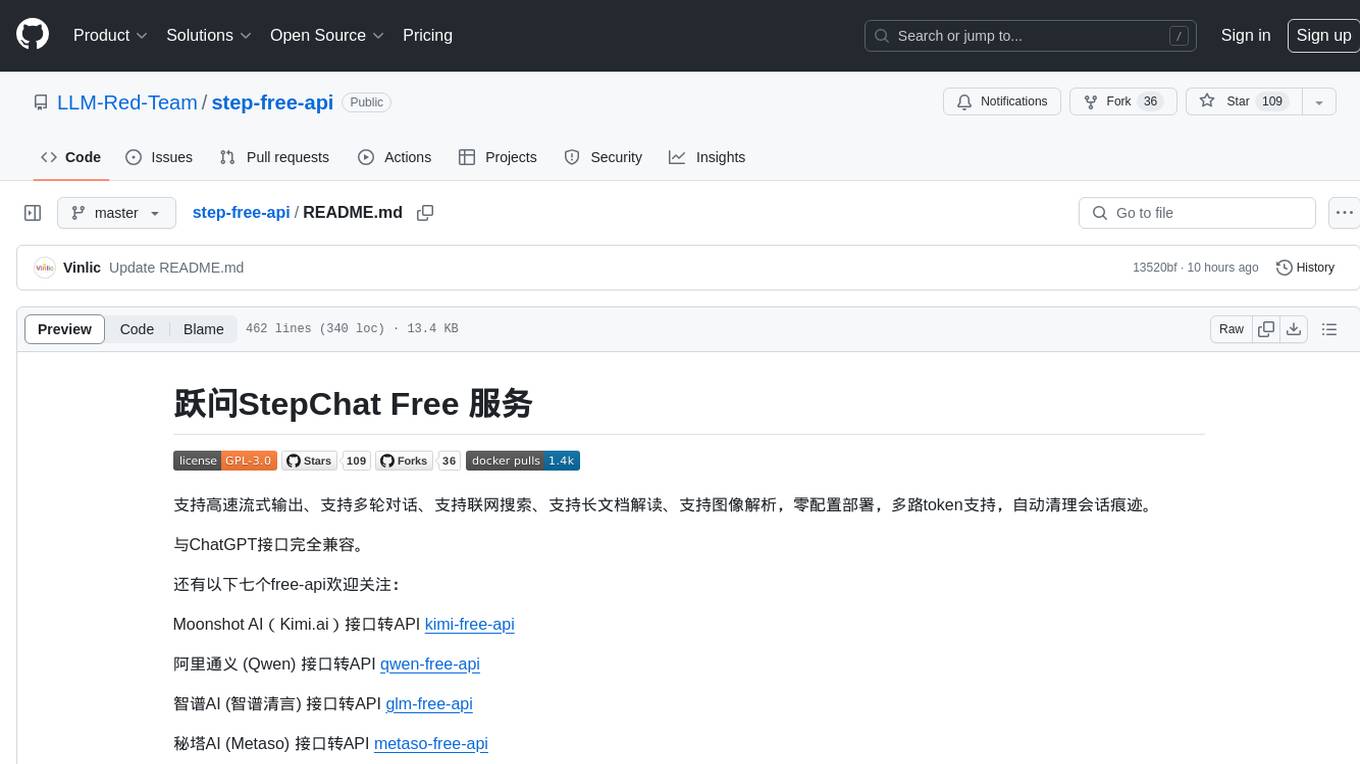
step-free-api
The StepChat Free service provides high-speed streaming output, multi-turn dialogue support, online search support, long document interpretation, and image parsing. It offers zero-configuration deployment, multi-token support, and automatic session trace cleaning. It is fully compatible with the ChatGPT interface. Additionally, it provides seven other free APIs for various services. The repository includes a disclaimer about using reverse APIs and encourages users to avoid commercial use to prevent service pressure on the official platform. It offers online testing links, showcases different demos, and provides deployment guides for Docker, Docker-compose, Render, Vercel, and native deployments. The repository also includes information on using multiple accounts, optimizing Nginx reverse proxy, and checking the liveliness of refresh tokens.

unilm
The 'unilm' repository is a collection of tools, models, and architectures for Foundation Models and General AI, focusing on tasks such as NLP, MT, Speech, Document AI, and Multimodal AI. It includes various pre-trained models, such as UniLM, InfoXLM, DeltaLM, MiniLM, AdaLM, BEiT, LayoutLM, WavLM, VALL-E, and more, designed for tasks like language understanding, generation, translation, vision, speech, and multimodal processing. The repository also features toolkits like s2s-ft for sequence-to-sequence fine-tuning and Aggressive Decoding for efficient sequence-to-sequence decoding. Additionally, it offers applications like TrOCR for OCR, LayoutReader for reading order detection, and XLM-T for multilingual NMT.
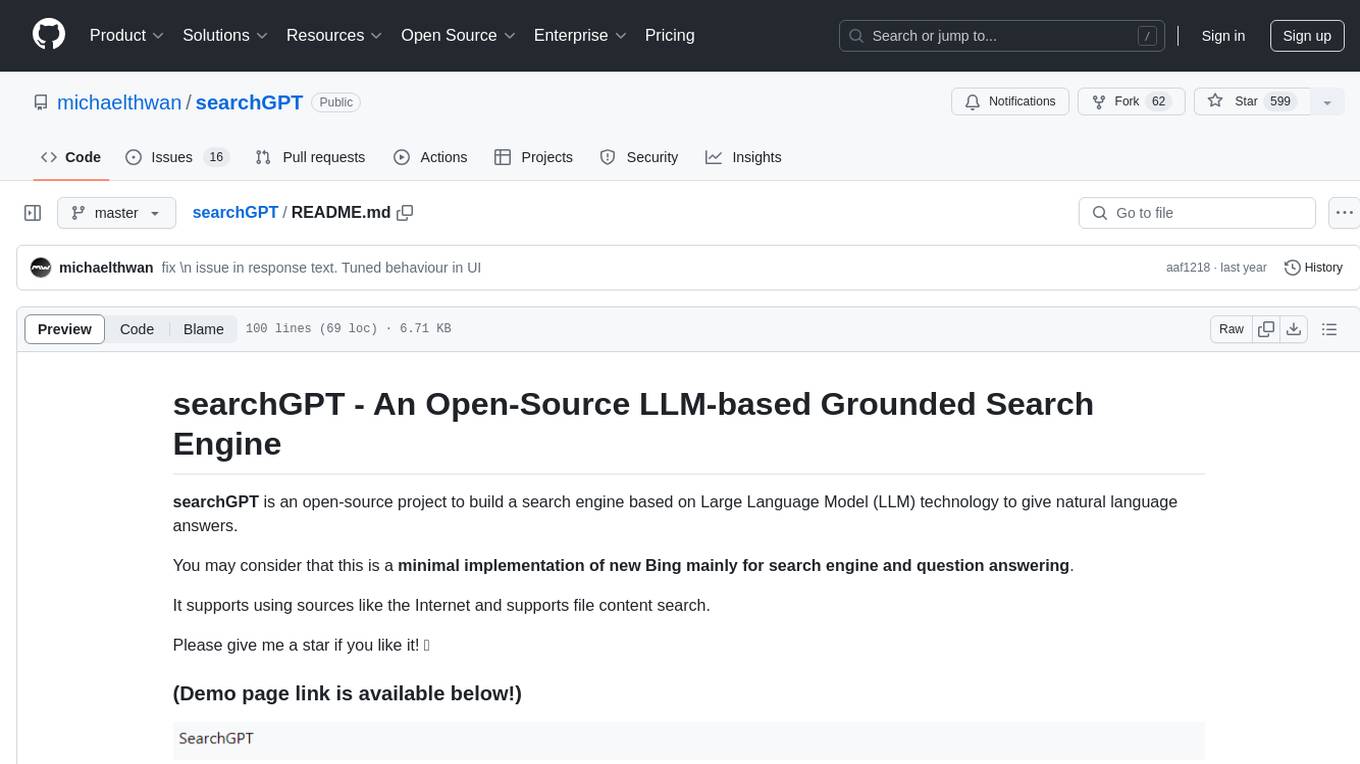
searchGPT
searchGPT is an open-source project that aims to build a search engine based on Large Language Model (LLM) technology to provide natural language answers. It supports web search with real-time results, file content search, and semantic search from sources like the Internet. The tool integrates LLM technologies such as OpenAI and GooseAI, and offers an easy-to-use frontend user interface. The project is designed to provide grounded answers by referencing real-time factual information, addressing the limitations of LLM's training data. Contributions, especially from frontend developers, are welcome under the MIT License.
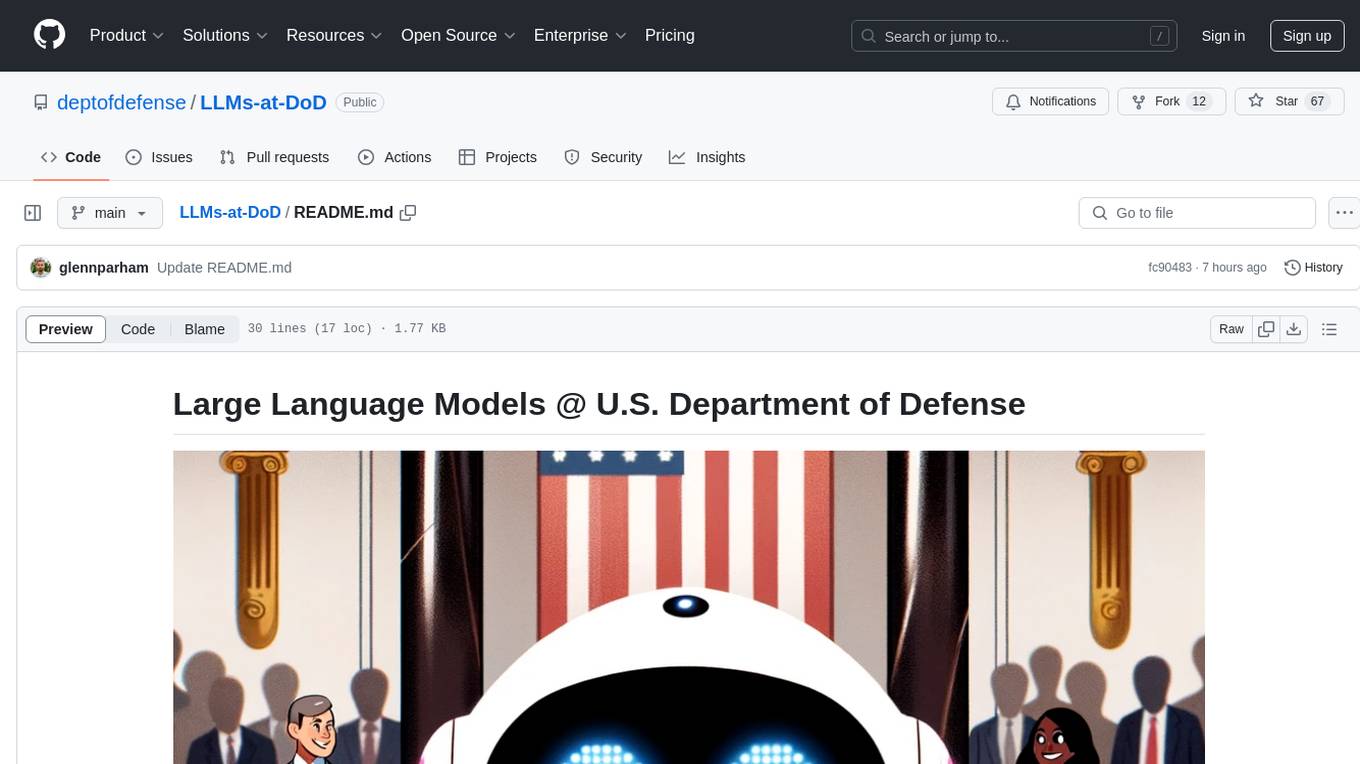
LLMs-at-DoD
This repository contains tutorials for using Large Language Models (LLMs) in the U.S. Department of Defense. The tutorials utilize open-source frameworks and LLMs, allowing users to run them in their own cloud environments. The repository is maintained by the Defense Digital Service and welcomes contributions from users.
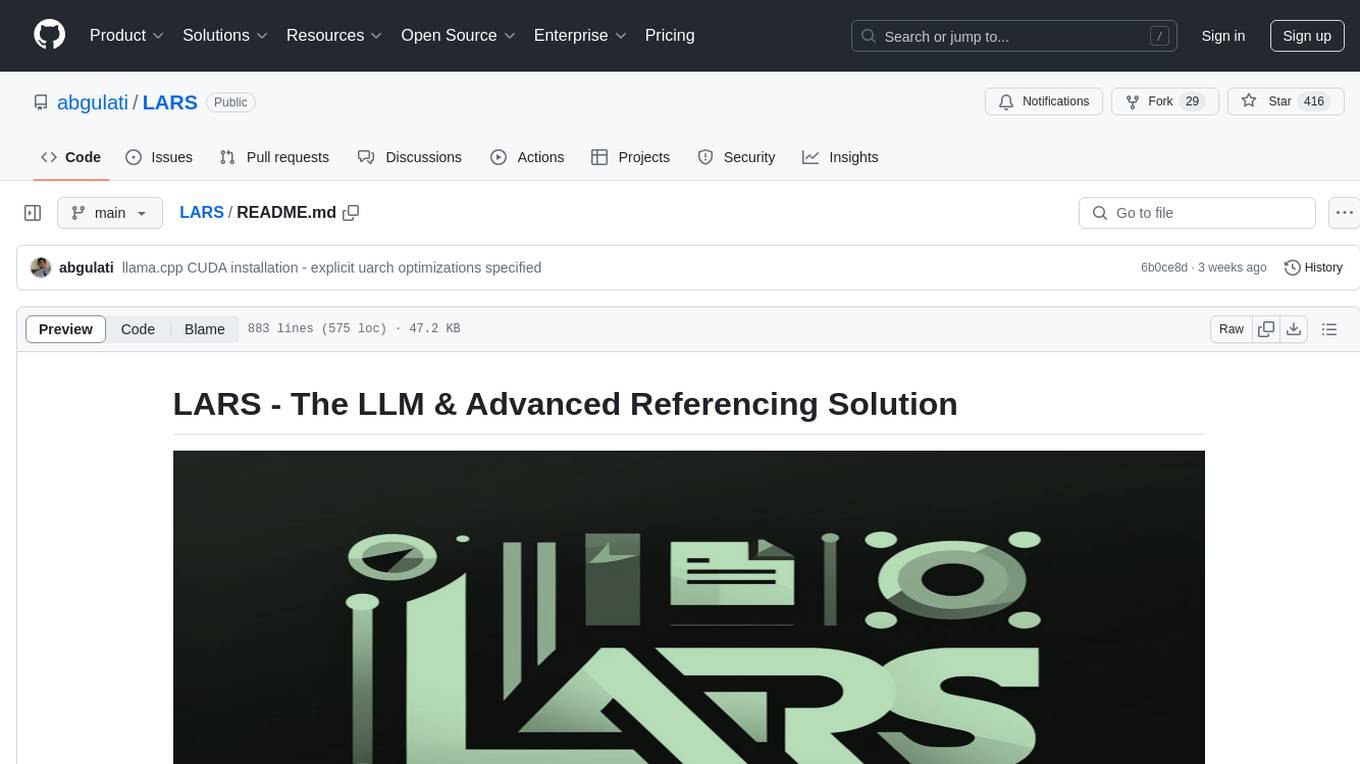
LARS
LARS is an application that enables users to run Large Language Models (LLMs) locally on their devices, upload their own documents, and engage in conversations where the LLM grounds its responses with the uploaded content. The application focuses on Retrieval Augmented Generation (RAG) to increase accuracy and reduce AI-generated inaccuracies. LARS provides advanced citations, supports various file formats, allows follow-up questions, provides full chat history, and offers customization options for LLM settings. Users can force enable or disable RAG, change system prompts, and tweak advanced LLM settings. The application also supports GPU-accelerated inferencing, multiple embedding models, and text extraction methods. LARS is open-source and aims to be the ultimate RAG-centric LLM application.
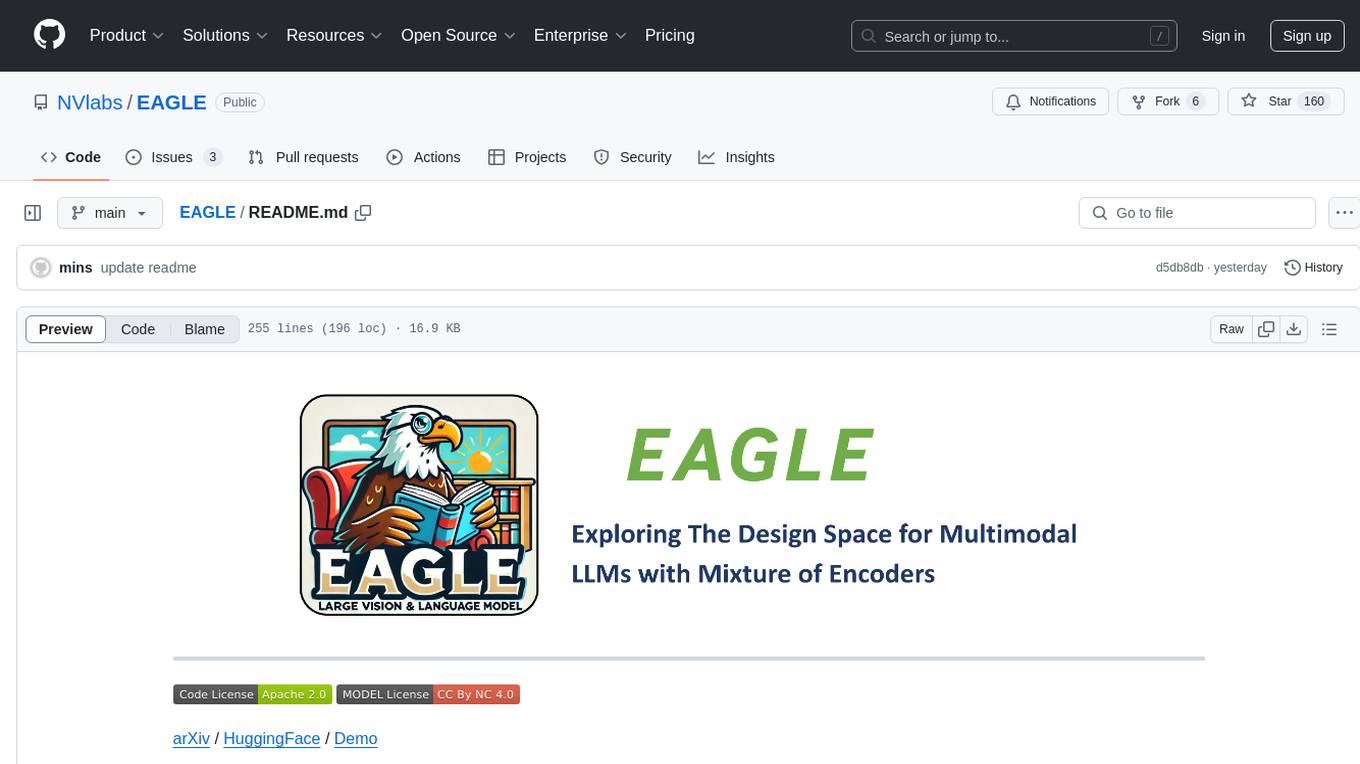
EAGLE
Eagle is a family of Vision-Centric High-Resolution Multimodal LLMs that enhance multimodal LLM perception using a mix of vision encoders and various input resolutions. The model features a channel-concatenation-based fusion for vision experts with different architectures and knowledge, supporting up to over 1K input resolution. It excels in resolution-sensitive tasks like optical character recognition and document understanding.
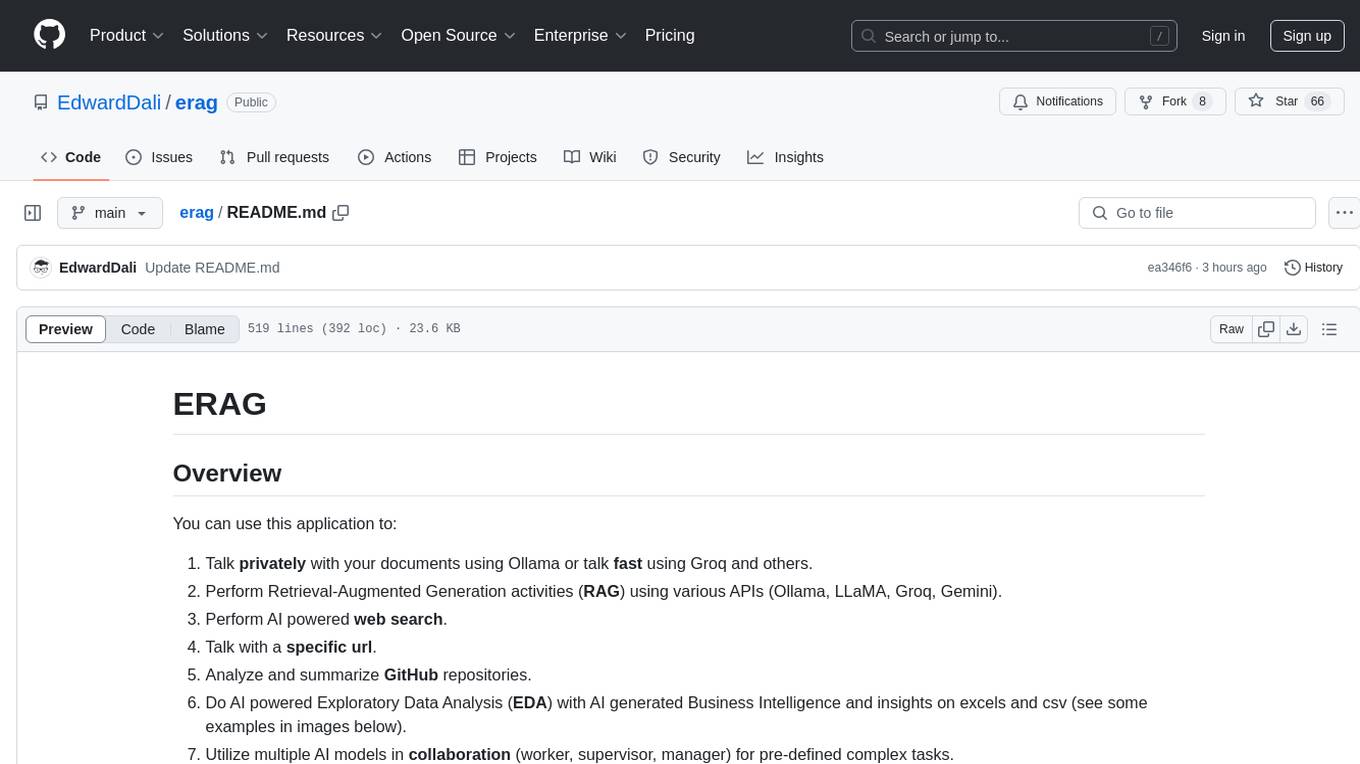
erag
ERAG is an advanced system that combines lexical, semantic, text, and knowledge graph searches with conversation context to provide accurate and contextually relevant responses. This tool processes various document types, creates embeddings, builds knowledge graphs, and uses this information to answer user queries intelligently. It includes modules for interacting with web content, GitHub repositories, and performing exploratory data analysis using various language models.
For similar jobs
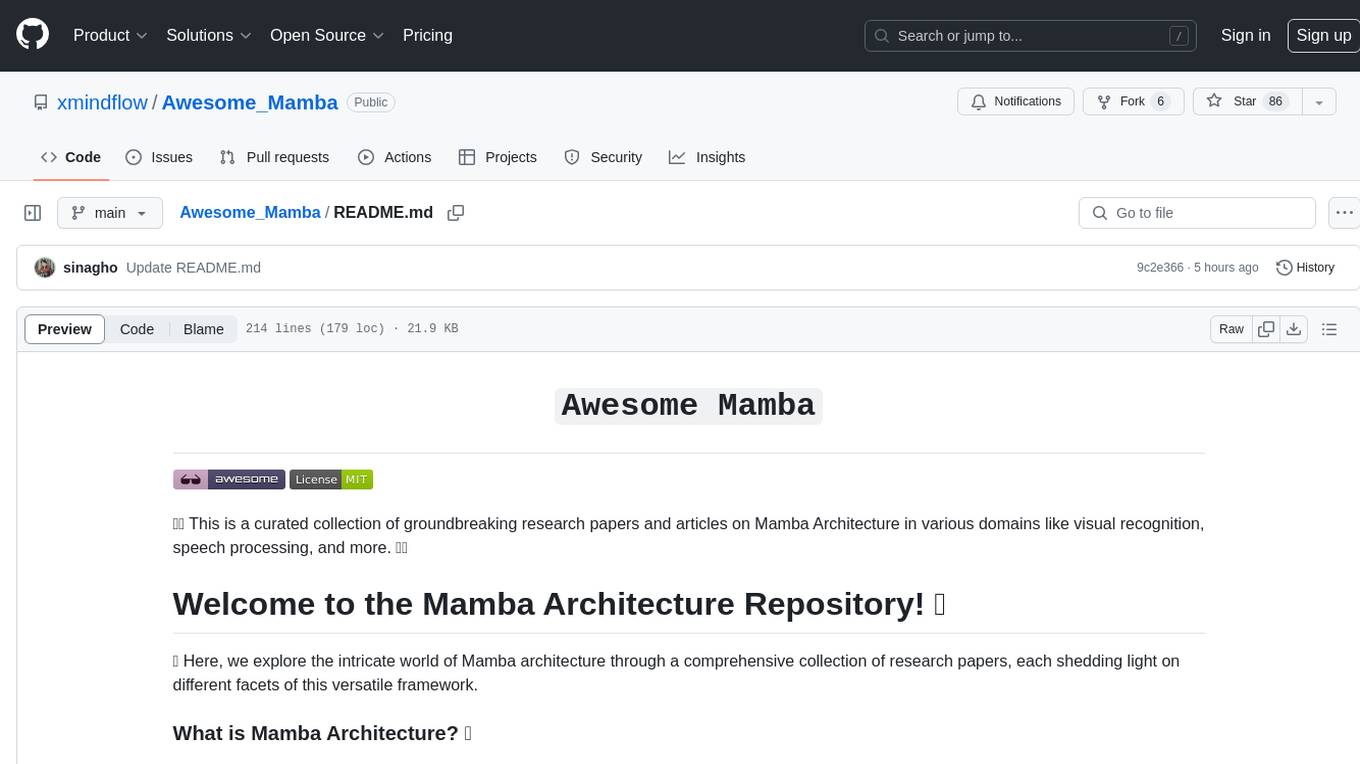
Awesome_Mamba
Awesome Mamba is a curated collection of groundbreaking research papers and articles on Mamba Architecture, a pioneering framework in deep learning known for its selective state spaces and efficiency in processing complex data structures. The repository offers a comprehensive exploration of Mamba architecture through categorized research papers covering various domains like visual recognition, speech processing, remote sensing, video processing, activity recognition, image enhancement, medical imaging, reinforcement learning, natural language processing, 3D recognition, multi-modal understanding, time series analysis, graph neural networks, point cloud analysis, and tabular data handling.

unilm
The 'unilm' repository is a collection of tools, models, and architectures for Foundation Models and General AI, focusing on tasks such as NLP, MT, Speech, Document AI, and Multimodal AI. It includes various pre-trained models, such as UniLM, InfoXLM, DeltaLM, MiniLM, AdaLM, BEiT, LayoutLM, WavLM, VALL-E, and more, designed for tasks like language understanding, generation, translation, vision, speech, and multimodal processing. The repository also features toolkits like s2s-ft for sequence-to-sequence fine-tuning and Aggressive Decoding for efficient sequence-to-sequence decoding. Additionally, it offers applications like TrOCR for OCR, LayoutReader for reading order detection, and XLM-T for multilingual NMT.
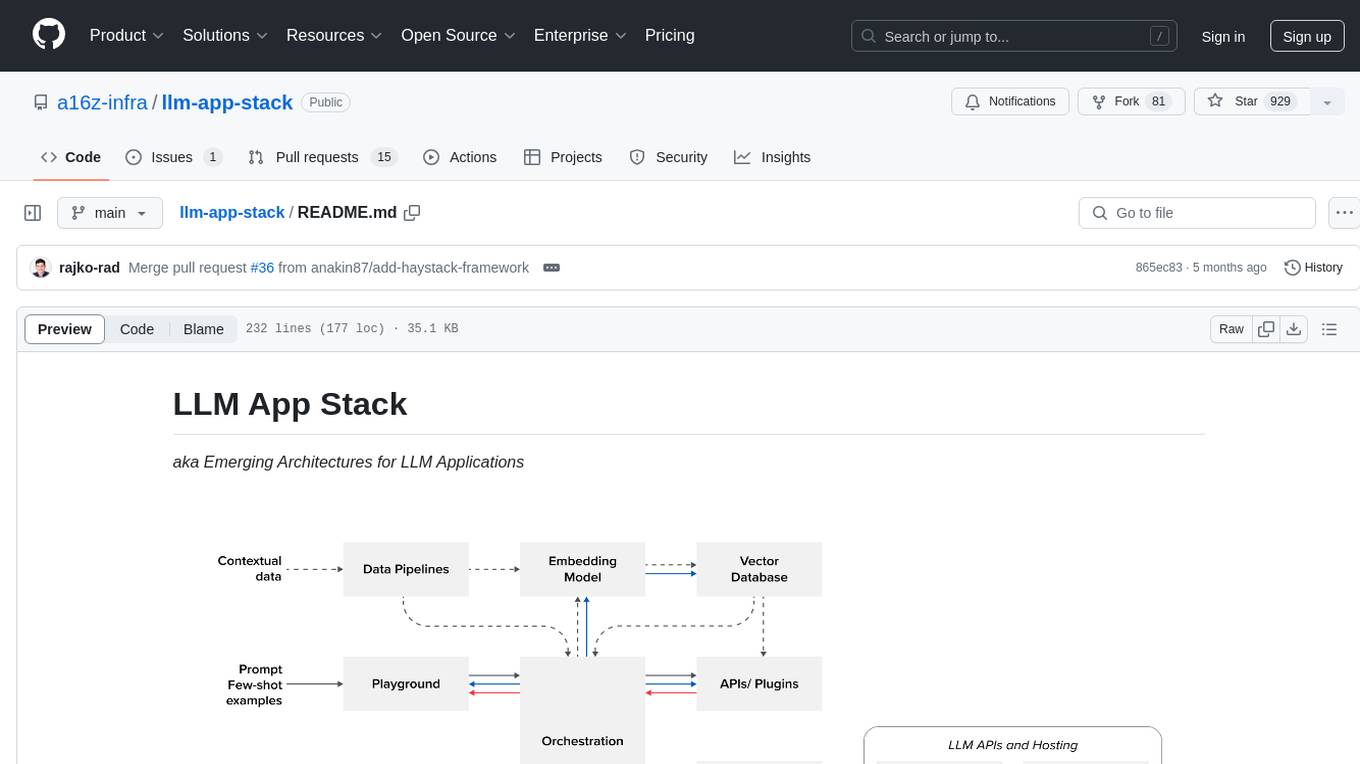
llm-app-stack
LLM App Stack, also known as Emerging Architectures for LLM Applications, is a comprehensive list of available tools, projects, and vendors at each layer of the LLM app stack. It covers various categories such as Data Pipelines, Embedding Models, Vector Databases, Playgrounds, Orchestrators, APIs/Plugins, LLM Caches, Logging/Monitoring/Eval, Validators, LLM APIs (proprietary and open source), App Hosting Platforms, Cloud Providers, and Opinionated Clouds. The repository aims to provide a detailed overview of tools and projects for building, deploying, and maintaining enterprise data solutions, AI models, and applications.
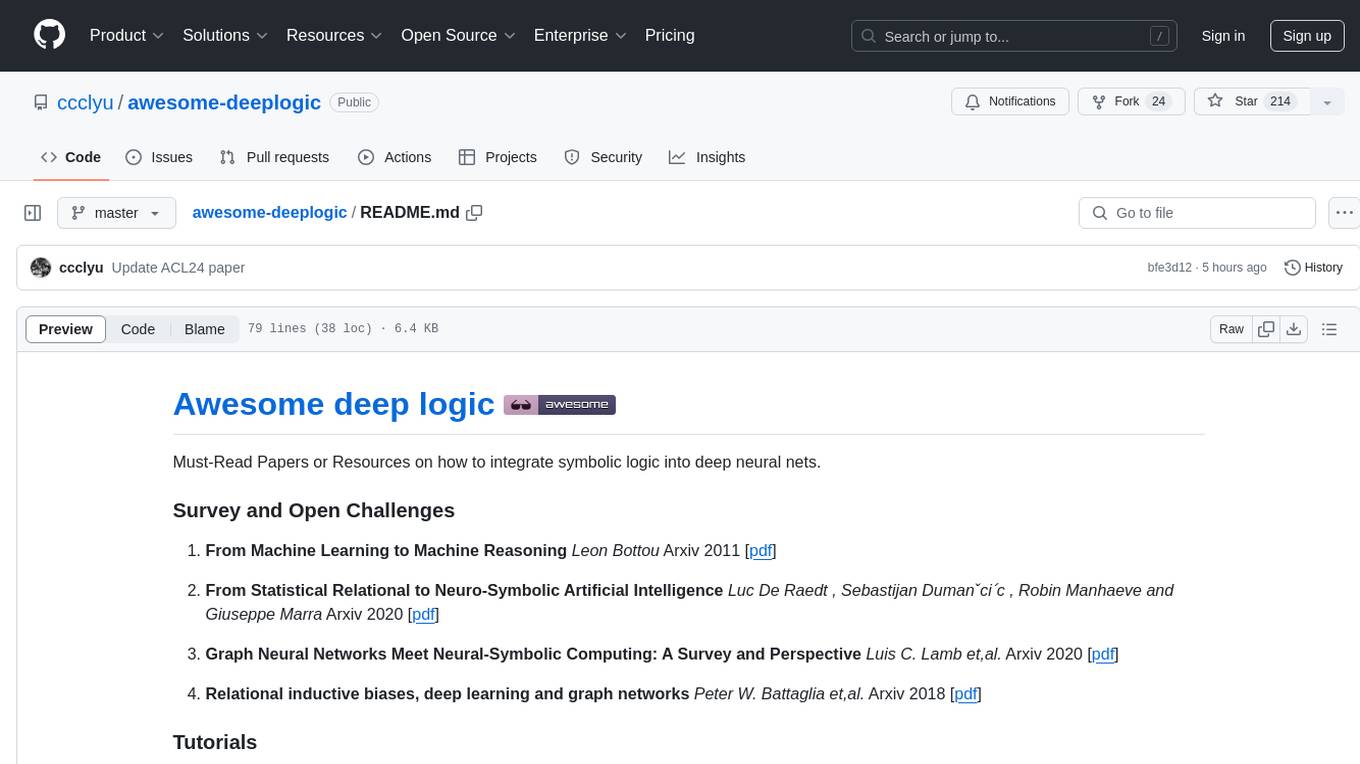
awesome-deeplogic
Awesome deep logic is a curated list of papers and resources focusing on integrating symbolic logic into deep neural networks. It includes surveys, tutorials, and research papers that explore the intersection of logic and deep learning. The repository aims to provide valuable insights and knowledge on how logic can be used to enhance reasoning, knowledge regularization, weak supervision, and explainability in neural networks.
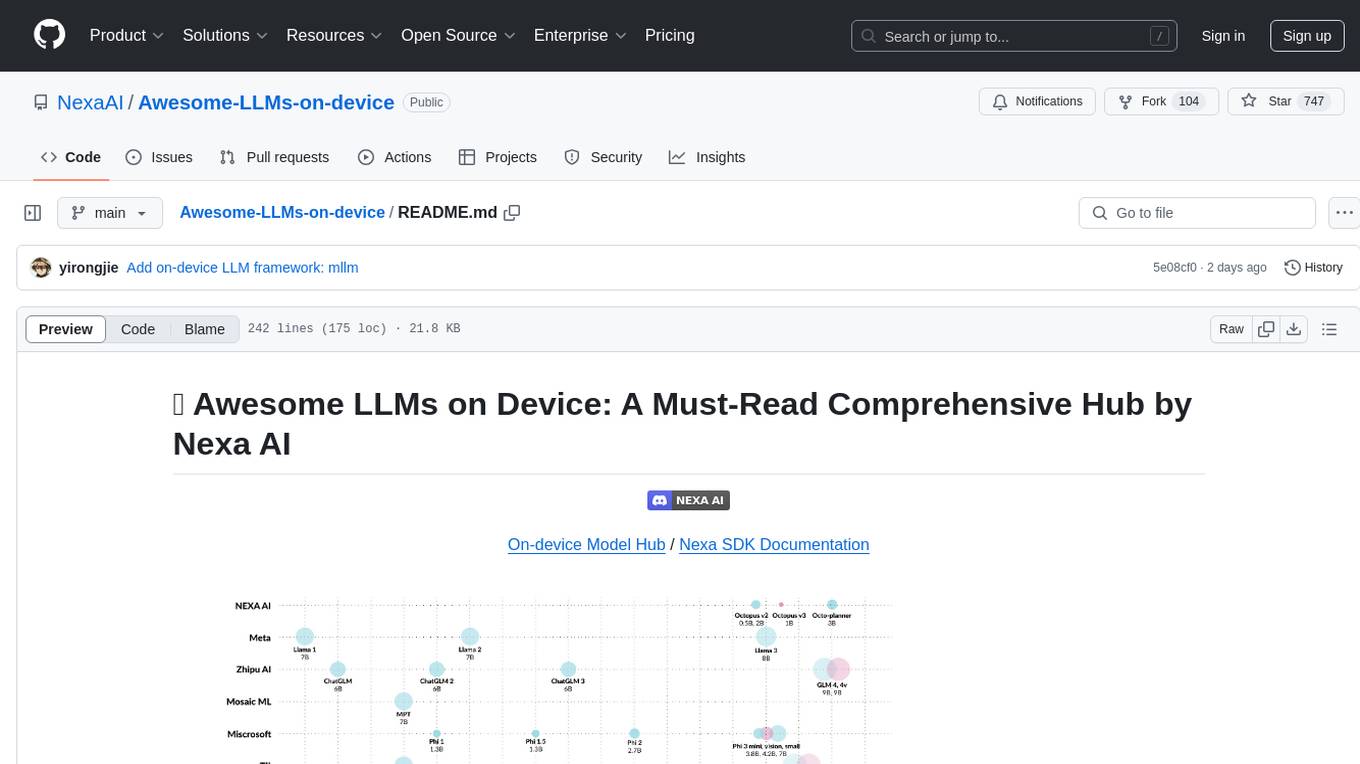
Awesome-LLMs-on-device
Welcome to the ultimate hub for on-device Large Language Models (LLMs)! This repository is your go-to resource for all things related to LLMs designed for on-device deployment. Whether you're a seasoned researcher, an innovative developer, or an enthusiastic learner, this comprehensive collection of cutting-edge knowledge is your gateway to understanding, leveraging, and contributing to the exciting world of on-device LLMs.
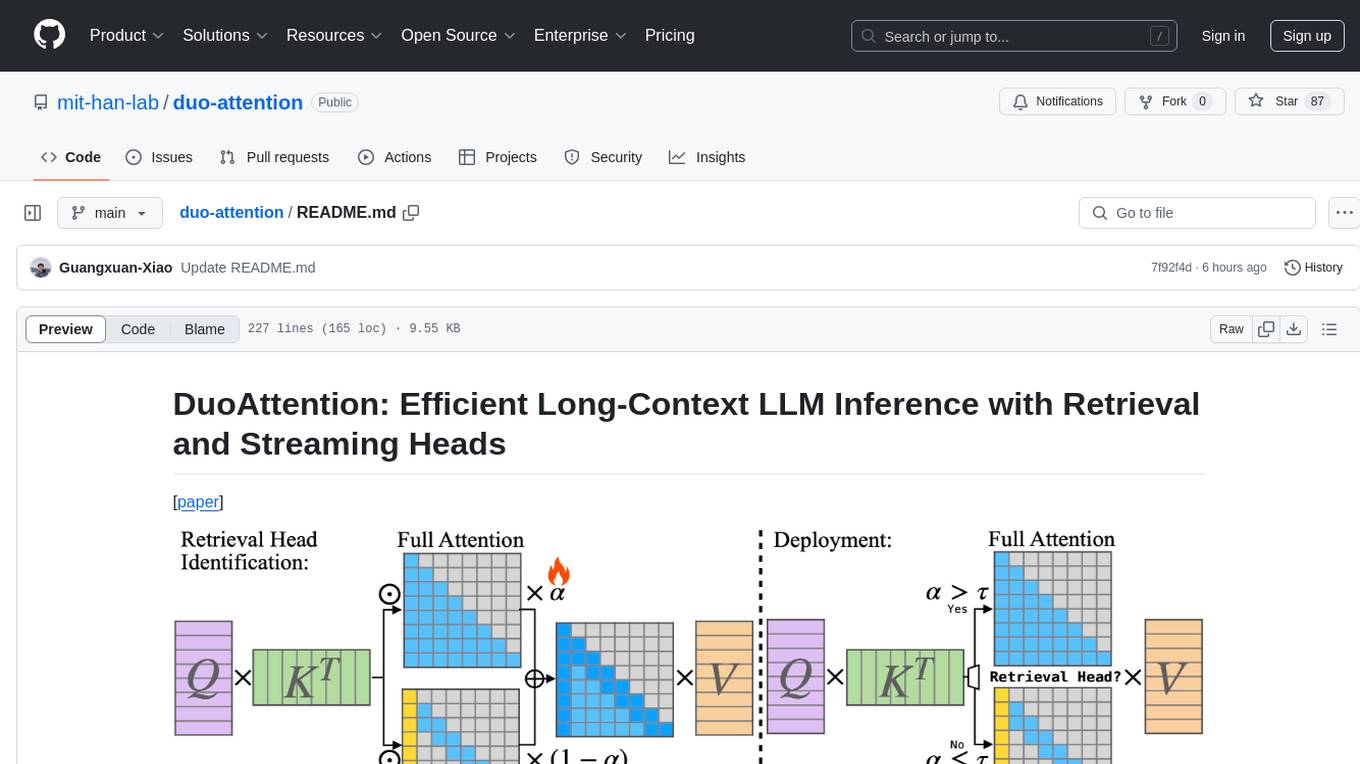
duo-attention
DuoAttention is a framework designed to optimize long-context large language models (LLMs) by reducing memory and latency during inference without compromising their long-context abilities. It introduces a concept of Retrieval Heads and Streaming Heads to efficiently manage attention across tokens. By applying a full Key and Value (KV) cache to retrieval heads and a lightweight, constant-length KV cache to streaming heads, DuoAttention achieves significant reductions in memory usage and decoding time for LLMs. The framework uses an optimization-based algorithm with synthetic data to accurately identify retrieval heads, enabling efficient inference with minimal accuracy loss compared to full attention. DuoAttention also supports quantization techniques for further memory optimization, allowing for decoding of up to 3.3 million tokens on a single GPU.
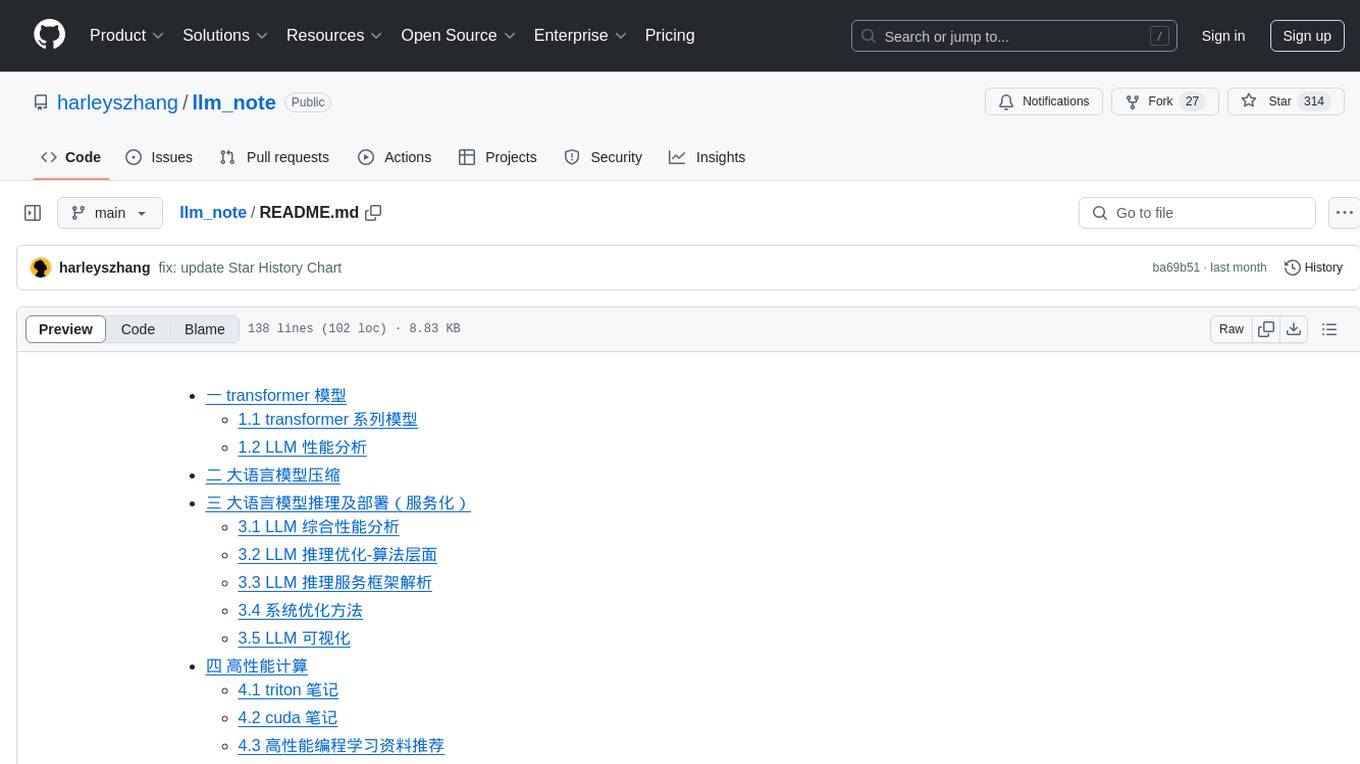
llm_note
LLM notes repository contains detailed analysis on transformer models, language model compression, inference and deployment, high-performance computing, and system optimization methods. It includes discussions on various algorithms, frameworks, and performance analysis related to large language models and high-performance computing. The repository serves as a comprehensive resource for understanding and optimizing language models and computing systems.
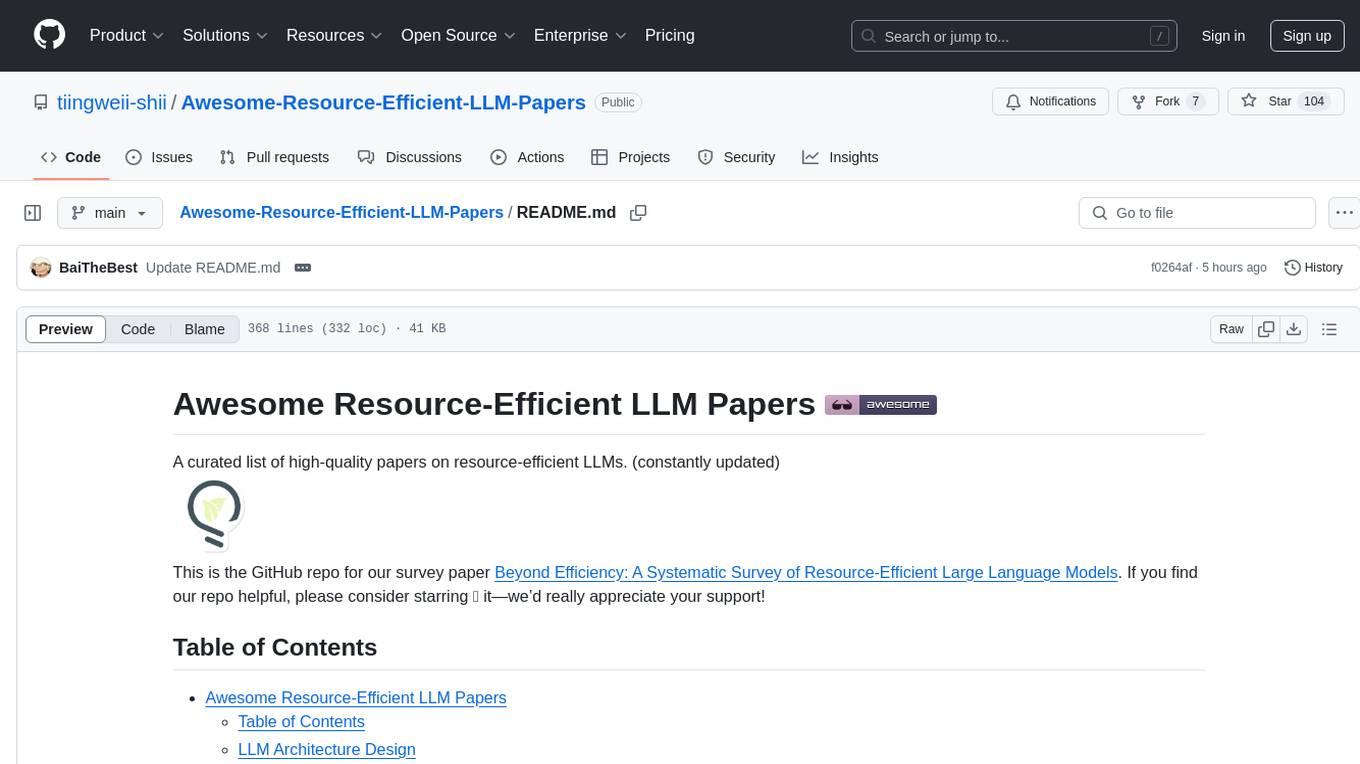
Awesome-Resource-Efficient-LLM-Papers
A curated list of high-quality papers on resource-efficient Large Language Models (LLMs) with a focus on various aspects such as architecture design, pre-training, fine-tuning, inference, system design, and evaluation metrics. The repository covers topics like efficient transformer architectures, non-transformer architectures, memory efficiency, data efficiency, model compression, dynamic acceleration, deployment optimization, support infrastructure, and other related systems. It also provides detailed information on computation metrics, memory metrics, energy metrics, financial cost metrics, network communication metrics, and other metrics relevant to resource-efficient LLMs. The repository includes benchmarks for evaluating the efficiency of NLP models and references for further reading.